DashClicks Blog
The industry's top experts offer their best advice, research, how-tos, and insights—all in the name of helping you level-up your business and online marketing skills.
Join Us!

Red Flags When Vetting a White Label SEO Partner
Selecting the right white label SEO partner can make or break your agency's reputation and client relationships. With 70% of marketers viewing SEO as more effective than PPC for generating sales, the stakes have never been higher for choosing a reliable white label SEO company.
White label SEO partnerships allow agencies to expand their service offerings without building in-house expertise. However, not all SEO white label services are created equal. The wrong partner can damage client relationships, harm your brand reputation, and waste valuable resources. This comprehensive guide reveals the critical red flags to avoid when evaluating potential white label SEO partners.
The white label SEO market has exploded as agencies seek to meet growing client demand for search engine optimization services. Yet this rapid growth has led to a proliferation of providers offering varying quality levels.
Understanding these warning signs will help you identify trustworthy partners who can deliver consistent, high-quality results for your clients.
Understanding White Label SEO Partnerships
White label SEO involves partnering with a specialized company that provides SEO services under your agency's brand name. Your clients receive professional SEO services without knowing about the third-party provider. This arrangement allows agencies to offer comprehensive SEO solutions while focusing on their core competencies.
A quality white label SEO partner should seamlessly integrate with your existing operations. They handle the technical aspects of SEO while you maintain client relationships and brand control. The best partnerships create a win-win scenario where your agency expands its service portfolio and the white label provider gains steady business.
However, the success of these partnerships depends entirely on choosing the right white label SEO company. Poor partner selection can lead to subpar results, client dissatisfaction, and potential damage to your agency's reputation.
Major Red Flags to Avoid
1. Guaranteed Rankings and Unrealistic Promises
The biggest red flag when evaluating any white label SEO partner is guaranteed rankings. No legitimate SEO provider can guarantee specific SERP positions due to the unpredictable nature of search algorithms. Companies making such promises often resort to black-hat techniques that can result in search engine penalties.
Google's algorithm considers over 200 ranking factors, many of which are beyond any SEO provider's direct control. Competitor actions, algorithm updates, and market changes all influence rankings. Reputable white label SEO companies set realistic expectations and focus on sustainable, long-term growth rather than quick fixes.
Be especially wary of partners promising first-page rankings within unrealistic timeframes. Quality SEO requires patience, consistent effort, and strategic planning. Companies offering overnight success likely use risky tactics that could harm your clients' websites.
2. Lack of Transparency in Reporting
Transparency forms the foundation of successful white label partnerships. If a potential partner hesitates to share detailed reports, methodologies, or progress metrics, consider it a major warning sign. You need complete visibility into the work being performed on your clients' behalf.
Quality white label SEO services provide comprehensive reporting that you can confidently share with clients. This includes keyword rankings, traffic analytics, backlink profiles, and technical audit results. Without transparent reporting, you cannot properly manage client expectations or demonstrate ROI.
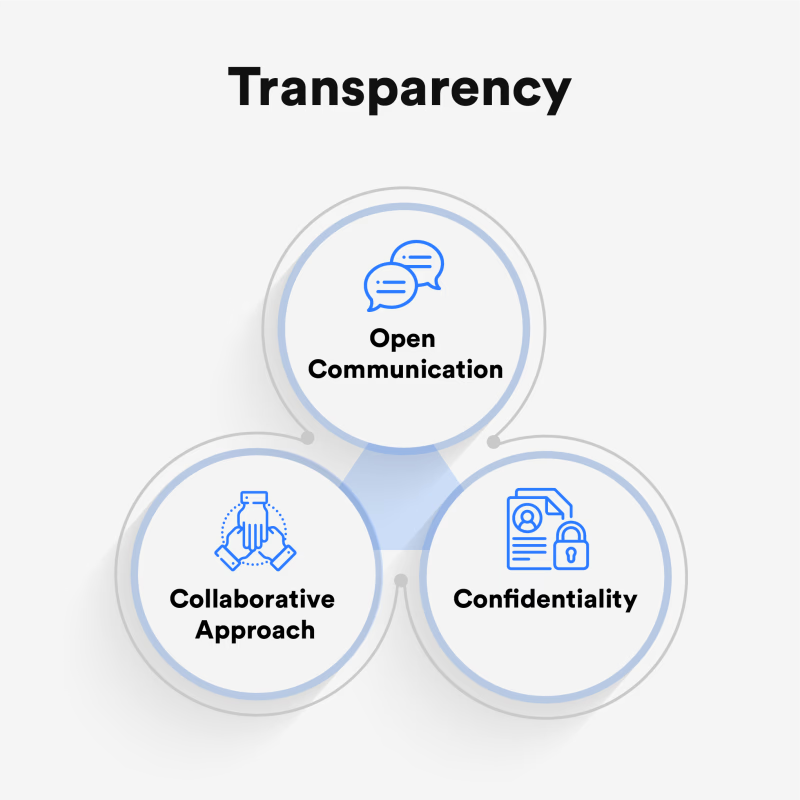
Image Source: WotNot
Some providers offer generic reports that lack client-specific insights. These cookie-cutter reports fail to provide actionable intelligence and may indicate a lack of personalized attention to your clients' unique needs.
Further Reading: The Importance of Transparency for Agency to Create Valuable Client Relationships
3. Suspiciously Low Pricing
While cost considerations are important, extremely low pricing often indicates compromised quality or unethical practices. Effective SEO requires skilled professionals, quality tools, and significant time investment. Providers offering prices far below market rates likely cut corners in crucial areas.
Low-cost providers may use automated tools exclusively, outsource work to inexperienced freelancers, or employ black-hat techniques. These approaches can deliver short-term results but often lead to long-term problems, including search engine penalties and damaged client relationships.
Consider the total cost of partnership beyond initial pricing. Hidden fees, poor results requiring remediation, and client churn due to subpar service can make cheap providers extremely expensive in the long run.
4. One-Size-Fits-All Approach
Every business has unique SEO needs based on industry, target audience, competition, and business goals. A white label SEO partner offering identical packages for all clients likely cannot deliver optimal results for your diverse client base.
Quality providers conduct thorough analyses of each client's situation before developing customized strategies. They consider factors like current website performance, competitive landscape, target keywords, and business objectives. This personalized approach ensures strategies align with specific client needs.
Avoid partners who refuse to customize their approach or claim their standard package works for everyone. Effective SEO requires flexibility and adaptation to each client's unique circumstances.
5. Poor Communication and Support
Communication challenges can severely impact white label partnerships. If a provider demonstrates poor communication during the sales process, expect similar issues during the partnership. Timely, clear communication is essential for managing client expectations and addressing urgent issues.
Evaluate response times, communication channels, and the quality of initial interactions. Partners should provide dedicated account managers, regular update calls, and responsive support for urgent situations. Poor communication can damage client relationships and reflect poorly on your agency.
Consider time zone differences and language barriers that might affect communication quality. Some providers offer 24/7 support, while others operate within specific business hours. Choose partners whose communication style and availability align with your client service standards.
6. Outdated or Black-Hat Techniques
SEO best practices evolve constantly as search engines update their algorithms. Partners using outdated techniques or black-hat practices can harm your clients' websites and your agency's reputation. Stay alert for providers who focus heavily on tactics like keyword stuffing, link farms, or content spinning.
Modern SEO emphasizes user experience, quality content, and technical optimization. Partners should demonstrate knowledge of current best practices, including Core Web Vitals, E-E-A-T (Experience, Expertise, Authoritativeness and Trustworthiness), and mobile-first indexing.
Ask potential partners about their approach to recent algorithm updates and how they adapt strategies accordingly. Providers who cannot discuss recent changes or rely on outdated techniques pose significant risks to your clients' online presence.
7. Lack of Industry Experience
While general SEO knowledge is important, industry-specific experience can significantly impact results. Partners with experience in your clients' industries understand unique challenges, competition levels, and effective strategies.
Evaluate case studies and client testimonials from similar industries. Partners should demonstrate successful outcomes for businesses comparable to your clients. This experience helps them develop more effective strategies and avoid common pitfalls.
However, don't automatically dismiss providers without direct industry experience if they demonstrate strong SEO fundamentals and willingness to learn. Sometimes fresh perspectives can identify opportunities that industry veterans might overlook.
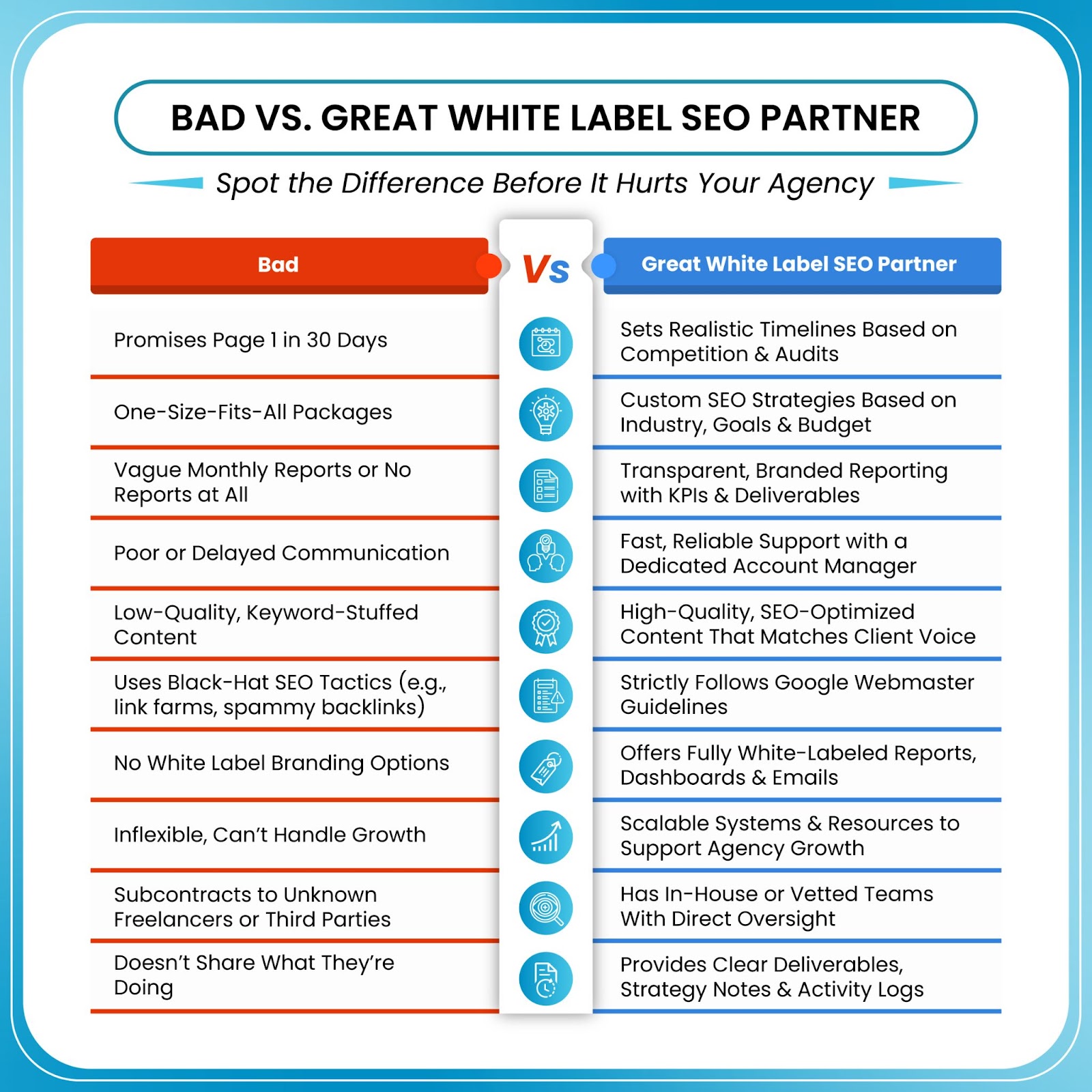
Essential Questions to Ask Potential Partners
1. Strategy and Methodology Questions
Before committing to any white label SEO company, ask detailed questions about their approach and methodologies. Request information about their keyword research process, content creation strategies, and link-building techniques. Quality providers should readily explain their processes and provide examples of successful implementations.
Ask about their approach to technical SEO, including site speed optimization, mobile responsiveness, and crawlability improvements. Understanding their methodology helps you evaluate whether their approach aligns with your quality standards and client expectations.
Inquire about their content creation process and whether they employ native English speakers for content development. Poor quality content can harm SEO efforts and damage client relationships, making this a crucial consideration.
2. Reporting and Communication
Discuss reporting frequency, format, and level of detail. Determine whether reports are automated or include human analysis and recommendations. Quality partners provide regular, comprehensive reports that demonstrate progress and identify improvement opportunities.
Ask about communication protocols for urgent issues or client concerns. Understand escalation procedures and expected response times for different types of requests. Clear communication expectations prevent misunderstandings and ensure smooth operations.

Inquire about client portal access and whether you can provide clients with direct access to certain reports or dashboards. This transparency can strengthen client relationships and reduce your administrative burden.
3. Scalability and Flexibility
Evaluate the provider's ability to scale services as your agency grows. Discuss their capacity to handle increased client loads and whether they can adapt to changing client needs. Scalable partners support your agency's growth without compromising service quality.
Ask about their flexibility in customizing services for different client types or industries. Understanding their adaptability helps you determine whether they can meet diverse client needs effectively.
Discuss contract terms and flexibility for adjusting service levels based on client requirements or budget changes. Flexible partners make it easier to maintain client relationships during changing circumstances.
Due Diligence Best Practices
1. Reference Checks and Case Studies
Request detailed case studies that demonstrate successful outcomes for similar clients. Quality white label SEO partners should provide specific examples of improved rankings, increased traffic, and enhanced conversions. Analyze these case studies for relevance to your client base.
Contact references directly to discuss their experience with the provider. Ask about communication quality, results delivery, and overall satisfaction. Previous clients can provide valuable insights into the provider's strengths and potential weaknesses.
Verify case study claims through third-party tools when possible. Some providers may exaggerate results or present incomplete information. Independent verification helps ensure accuracy and builds confidence in the partnership.
2. Trial Periods and Pilot Projects
Consider starting with a trial period or pilot project to evaluate the provider's capabilities before committing to a long-term partnership. This approach allows you to assess their work quality, communication style, and results delivery without significant risk.
Define clear success metrics for the trial period, including specific deliverables and performance benchmarks. This objective evaluation helps you make informed decisions about continuing the agency-client relationship.
Use pilot projects to test the provider's ability to meet deadlines, follow instructions, and deliver quality work. These small-scale tests can reveal potential issues before they impact major client relationships.
3. Contract Terms and Service Level Agreements
Carefully review contract terms, paying particular attention to service level agreements (SLAs), termination clauses, and performance guarantees. Understand your rights and obligations under the agreement, as well as procedures for addressing performance issues.
Ensure the contract includes provisions for data ownership and client confidentiality. You should retain ownership of all work performed for your clients and have assurances about data security and privacy protection.
Discuss penalty clauses for missed deadlines or subpar performance. Quality providers should be willing to include reasonable penalties that protect your interests while maintaining realistic expectations.
Making the Right Choice
Selecting the right white label SEO partner requires careful evaluation of multiple factors beyond just pricing and service offerings. The ideal partner combines technical expertise, industry experience, transparent communication, and a commitment to ethical practices.
Take time to thoroughly vet potential partners through reference checks, trial periods, and detailed discussions about their methodologies. The investment in proper due diligence pays dividends through stronger client relationships, better results, and reduced risk exposure.
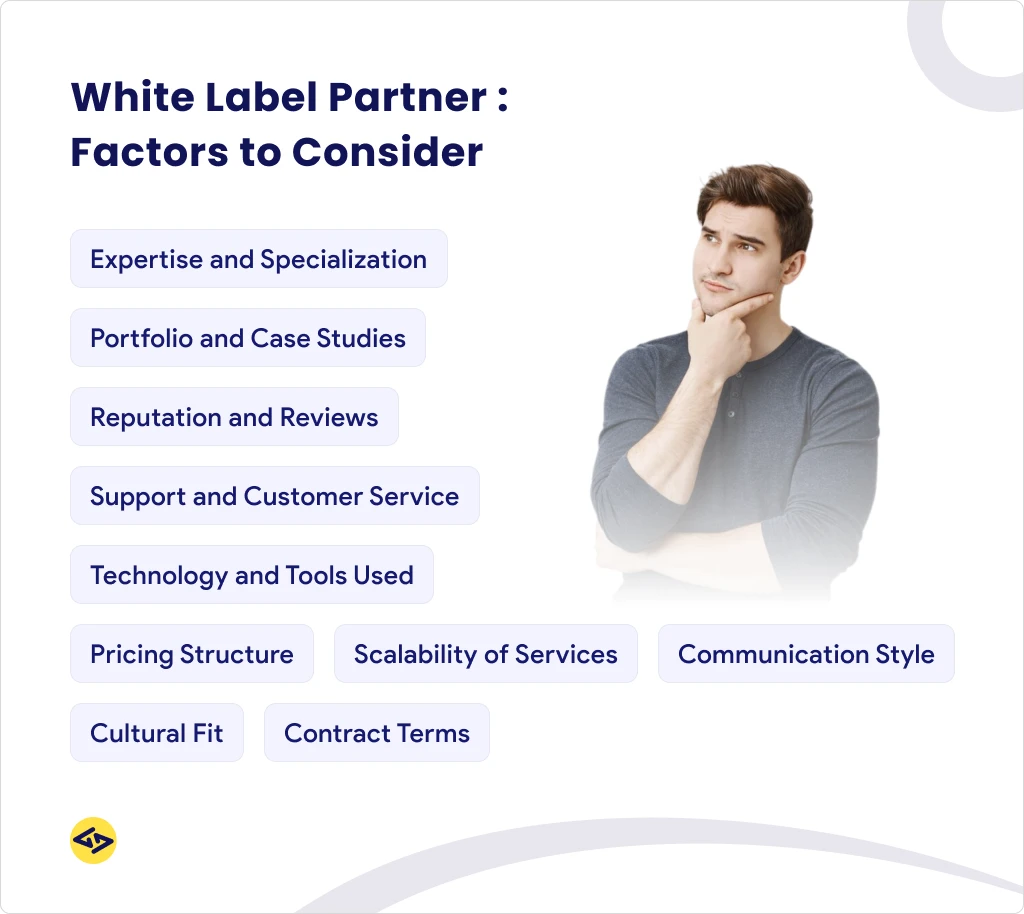
Image Source: iCoderz
Remember that the cheapest option rarely provides the best value. Focus on partners who demonstrate consistent results, ethical practices, and the ability to scale with your agency's growth. Quality white label SEO services represent an investment in your agency's future success.
Building Long-Term Partnership Success
The most successful white label SEO partnerships extend beyond simple vendor relationships. Look for partners who view themselves as extensions of your team and demonstrate genuine interest in your clients' success. These collaborative relationships produce better results and create more sustainable business models.
Establish regular communication schedules and performance review processes to ensure the partnership continues meeting your needs. Address issues promptly and maintain open dialogue about changing requirements or market conditions.
Consider the provider's investment in ongoing education and industry developments. SEO evolves rapidly, and partners who stay current with SEO best practices and algorithm changes provide better long-term value.
or support to help you field technical questions, while others prefer to remain completely invisible to your clients.
Why DashClicks is the Ultimate Partner for White Label SEO Services
When it comes to white label SEO services, DashClicks is more than just a provider – it’s a partner designed to help agencies thrive. Here's why partnering with DashClicks is a smart choice for growing your business:
- Transparency You Can Trust: DashClicks is built on a foundation of transparency, ensuring you and your clients are always in the loop. Their platform provides detailed, easy-to-understand reports and analytics, allowing you to showcase measurable results with confidence. This transparency helps build trust with your clients while strengthening your reputation as a dependable agency.
- Efficiency That Saves Time: Managing SEO campaigns can be complex and time-consuming. They simplify this through its robust, user-friendly platform designed to streamline workflows. You can manage multiple campaigns effortlessly, leaving you with more time to focus on scaling your agency and serving clients effectively.
- Cutting-Edge Tools and Resources: With DashClicks, you gain access to advanced tools and resources that elevate your SEO campaigns. From keyword research and website audits to tracking rankings and optimizing strategies, their platform is equipped with everything you need to deliver exceptional results.
- Dedicated Support That Has Your Back: Not only do you receive top-tier tools, but they also offer a dedicated support team ready to assist you at every step. Whether you’re handling client inquiries or facing roadblocks, their team is there to ensure you have everything you need to succeed.
- Focus on Growth, Not Technicalities: By partnering with white label SEO services provider, you can delegate the technical complexities of SEO to an experienced and trusted team. This allows you to channel your energy into expanding your client base, refining your services, and driving revenue growth.
DashClicks isn’t just a service provider—it’s an enabler of success for agencies looking to scale with confidence. With their transparent processes, advanced tools, and reliable support, you can deliver consistent results to your clients while focusing on what matters most: growing your business.
Frequently Asked Questions
Q1. How Do I Evaluate a White Label SEO Company’s Technical Capabilities?
Ans. Request detailed information about their technical SEO processes, including site audit procedures, page speed optimization techniques, and mobile responsiveness improvements. Ask for examples of technical improvements they've implemented and their results. Quality providers should demonstrate proficiency with industry-standard tools and current best practices.
Q2. What Should I Expect in Terms of Reporting from SEO White Label Services?
Ans. Comprehensive reporting should include keyword rankings, organic traffic growth, backlink profiles, technical audit results, and competitive analysis. Reports should be branded with your agency's logo and provide actionable insights rather than just raw data. Monthly reporting is standard, with some providers offering more frequent updates for critical metrics.
Q3. How Long Should I Expect to See Results from a White Label SEO Partner?
Ans. Legitimate SEO results typically begin appearing within 3-6 months, with more significant improvements visible after 6-12 months. Be wary of partners promising immediate results or dramatic improvements within the first month. Sustainable SEO requires time to build authority and trust with search engines.
Q4. What Are the Typical Contract Terms for White Label SEO Partnerships?
Ans. Most white label SEO companies offer month-to-month agreements or annual contracts with better pricing. Look for contracts that include clear service level agreements, performance metrics, and termination clauses. Avoid providers requiring long-term commitments without trial periods or performance guarantees.
Q5. How Do I Handle Client Questions About SEO Work Performed by My White Label Partner?
Ans. Maintain regular communication with your white label partner to stay informed about ongoing work and results. Request detailed reporting that you can confidently discuss with clients. Some providers offer training or support to help you field technical questions, while others prefer to remain completely invisible to your clients.
Your Next Steps for SEO Success
Choosing the right white label SEO partner is crucial for your agency's growth and client satisfaction. By avoiding these red flags and conducting thorough due diligence, you can build profitable partnerships that deliver consistent results.
Start by creating a detailed evaluation framework that includes the criteria discussed in this guide. Use this framework to objectively assess potential partners and make informed decisions based on facts rather than sales presentations.
Remember that the best white label SEO partnerships are built on trust, transparency, and shared commitment to client success. Take the time to find partners who align with your values and quality standards—your clients and your agency's reputation depend on it.
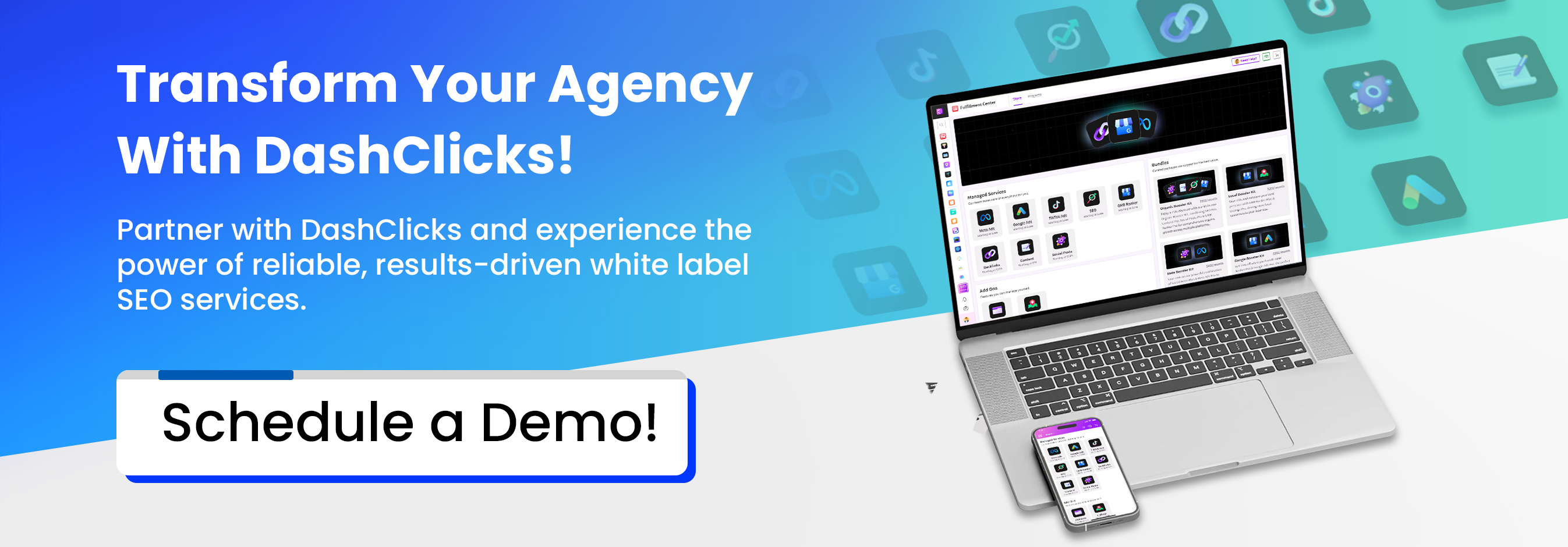

From 5 to 50 Clients: Scaling Strategies Using SEO Reselling
Growing from a handful of clients to dozens isn't just about working harder—it's about working smarter. SEO reselling offers agencies and entrepreneurs a proven path to scale without the overhead of building an entire SEO team from scratch.
The digital marketing industry is experiencing unprecedented growth, with the global SEO services market expected to reach $103,236.2 million by 2025. This surge creates massive opportunities for resellers who understand how to effectively leverage white-label SEO services.
But scaling isn't automatic. It requires strategic planning, smart partnerships, and proven systems that can handle growth without compromising quality. This guide reveals the exact strategies successful resellers use to multiply their client base while maintaining profitability.
Understanding the SEO Reselling Landscape
SEO reselling involves partnering with established SEO agencies to deliver services under your brand name. You handle client relationships and sales while your partner manages the technical execution. This model allows agencies to offer comprehensive SEO services without hiring specialists or investing in expensive tools.
The reselling market has matured significantly. According to industry data, 73% of agencies now offer some form of white-label services, compared to just 41% five years ago. This growth reflects the increasing demand for specialized digital marketing services and the challenges of building in-house expertise.
Key Market Drivers
Several factors fuel the SEO reseller program:
- Rising SEO Demand: Small and medium businesses increasingly recognize SEO's importance. BrightLocal's 2024 survey found that 86% of local businesses invest in SEO, up from 74% in 2020.
- Skill Gap Reality: Building an effective SEO team requires expertise in technical SEO, content marketing, link building, and analytics. Many agencies struggle to find qualified professionals—the average time to fill an SEO specialist position is 68 days.
- Cost Efficiency: Hiring a senior SEO specialist costs $65,000-$95,000 annually, plus benefits and tools. Reseller partnerships often provide better ROI, especially for agencies handling fewer than 30 SEO clients.
- Client Expectations: Modern clients expect comprehensive digital marketing services. Agencies that can't deliver SEO risk losing clients to full-service competitors.
The 5-Client Foundation: Building Your Starting Point
Most successful SEO resellers begin with a small, manageable client base. This foundation phase is crucial for understanding client needs, refining processes, and establishing proof of concept.
A. Identifying Your Ideal Starting Clients
Your first five clients should share certain characteristics that make them ideal for testing and refining your reselling model:
- Local Businesses With Clear Needs: Restaurants, dental practices, law firms, and home service companies often have straightforward SEO requirements and can see results quickly.
- Existing Relationships: Current clients who trust your expertise are more likely to try new services. They're also more forgiving during the initial learning phase.
- Budget Capacity: Focus on clients who can afford $1,500-$3,000 monthly for SEO services. This range allows for meaningful work while providing reasonable margins.
- Growth Potential: Choose clients in expanding markets or those planning business growth. Their success creates case studies and referral opportunities.
B. Setting Up Your Initial Systems
Before taking on your first SEO reseller clients, establish these foundational systems:
- Client Onboarding Process: Develop a standardized approach for gathering client information, setting expectations, and defining success metrics. This includes technical audits, competitor analysis, and goal-setting sessions.
- Communication Framework: Establish regular reporting schedules, preferred communication channels, and escalation procedures. Many resellers use client portals for transparency and self-service access.
- Performance Tracking: Implement systems for monitoring rankings, traffic, and conversions. Tools like Google Analytics, Search Console, and rank tracking software are essential.
- Quality Assurance: Create checkpoints for reviewing work before client delivery. This includes content approval, technical audit verification, and campaign performance analysis.
Strategic Partnerships: Choosing Your SEO Provider
Your reselling success depends heavily on your SEO partner's capabilities, reliability, and alignment with your business goals. The wrong partnership can damage agency-client relationship and limit growth potential.
A. Essential Partner Qualifications
- Technical Expertise: Your partner should demonstrate proficiency in technical SEO, content marketing, link building, and local SEO. Request case studies showing measurable results across different industries.
- Scalability: Can they handle your growth? Partners should have systems for managing increased workload without compromising quality. Ask about their current client capacity and team size.
- Reporting Capabilities: Look for partners who provide detailed, branded reports you can share with clients. White-label reporting tools should include rankings, traffic data, and clear explanations of work completed.
- Communication Standards: Your partner should respond promptly to questions and provide regular updates on campaign progress. Establish clear communication protocols upfront.
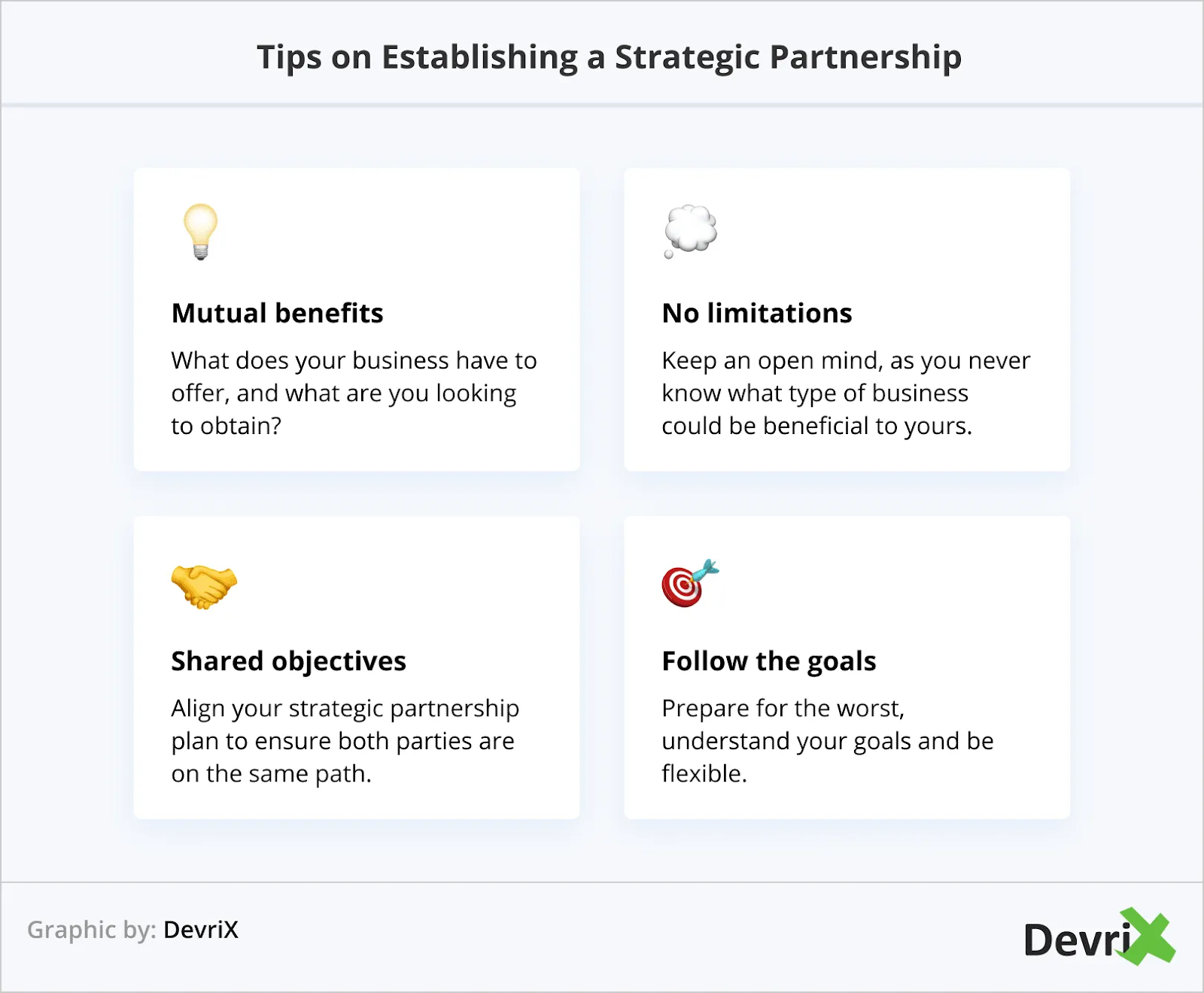
Image Source: DevriX
B. Red Flags to Avoid
- Guaranteed Rankings: No legitimate SEO provider can guarantee specific rankings. Google's algorithm changes make such promises impossible to fulfill.
- Lack of Transparency: Partners who won't explain their methods or provide detailed reporting create risks for your client relationships.
- Unrealistic Timelines: SEO results typically take 4-6 months to materialize. Partners promising immediate results likely use risky techniques.
- Poor Communication: Delayed responses, unclear explanations, or unwillingness to participate in client calls indicate potential problems.
The 10-Client Milestone: Systematizing Operations
Moving from 5 to 10 clients requires operational improvements and system refinements. This phase tests your ability to maintain quality while handling increased complexity.
A. Process Optimization
- Standardized Workflows: Document every step of your SEO delivery process. This includes client onboarding, monthly reporting, strategy development, and performance reviews.
- Automation Tools: Implement tools for automating routine tasks like report generation, rank tracking, and client communications. Popular options include SEMrush, Ahrefs, and white-label reporting platforms.
- Quality Control Systems: Establish review processes for all client deliverables. This might include content approval workflows, technical audit verification, and campaign performance analysis.
- Client Segmentation: Group clients by industry, service level, or complexity. This allows for more efficient resource allocation and specialized expertise development.
B. Team Development
Even with outsourced SEO services, you'll need internal support for client management, communication, and business development.
- Client Success Manager: Hire someone dedicated to client communication, reporting, and relationship management. This role is crucial for maintaining satisfaction as you scale.
- Business Development: As you prove SEO reselling success, invest in dedicated sales resources to accelerate growth. This might be a full-time salesperson or outsourced business development services.
- Project Management: Implement project management software and processes to coordinate between your team, clients, and SEO partners. Tools like DashClicks can help track progress and deadlines.
Scaling to 25 Clients: Advanced Growth Strategies
The jump from 10 to 25 clients represents a significant business transformation. You're moving from a small operation to a substantial revenue stream that requires more sophisticated management approaches.
A. Service Diversification
1. Tiered Service Offerings: Develop multiple service levels to accommodate different client budgets and needs. This might include:
- Basic SEO ($1,500/month): Local SEO, basic content, technical optimization.
- Standard SEO ($3,000/month): Comprehensive SEO, content marketing, link building.
- Premium SEO ($5,000+/month): Advanced strategies, competitor analysis, conversion optimization.
Here is an example -

2. Industry Specialization: Focus on specific industries where you can develop deep expertise. Specialized knowledge allows for premium pricing and more effective marketing.
3. Additional Services: Expand beyond SEO to include complementary services like PPC management, social media marketing, or web design. This increases client lifetime value and reduces churn.
B. Marketing and Sales Optimization
- Content Marketing Strategy: Develop a robust content marketing program showcasing your SEO expertise. This includes blog posts, case studies, webinars, and industry speaking opportunities.
- Referral Programs: Implement formal referral programs for existing clients. Satisfied clients are your best source of new business—make it easy for them to refer others.
- Partnership Development: Build relationships with complementary service providers like web designers, marketing consultants, and business coaches. These partnerships can provide steady referral streams.
- Sales Process Refinement: Develop a structured sales process with defined stages, qualification criteria, and conversion metrics. This allows for predictable growth and improved close rates.

C. Technology and Infrastructure
- CRM Implementation: Invest in a robust CRM software to manage client relationships, track sales opportunities, and monitor client satisfaction. Popular options include DashClicks, HubSpot, Salesforce, or Pipedrive.
- Financial Management: Implement proper accounting systems for tracking revenue, expenses, and profitability by client. This data is crucial for making informed business decisions.
- Performance Analytics: Develop comprehensive dashboards for monitoring business performance, client results, and operational efficiency. This includes client retention rates, average client value, and team productivity metrics.
Reaching 50 Clients: Operational Excellence
Managing 50 SEO clients requires sophisticated systems, skilled team members, and exceptional operational discipline. This scale represents a significant business milestone with substantial monthly recurring revenue.
A. Advanced Team Structure
1. Department Specialization: Organize your team into specialized departments:
- Client Success: Dedicated to client communication and satisfaction.
- Business Development: Focused on new client acquisition.
- Operations: Managing relationships with SEO partners and internal processes.
- Finance and Administration: Handling contracts, billing, and business operations.
2. Training and Development: Invest in ongoing team training to maintain service quality and stay current with industry trends. This includes SEO education, client service training, and business development skills.
3. Performance Management: Implement clear performance metrics and regular review processes. This ensures team members understand expectations and provides opportunities for professional development.
B. Client Retention Strategies
At 50 clients, retention becomes more critical than acquisition. Losing clients at this scale can significantly impact revenue and profitability.
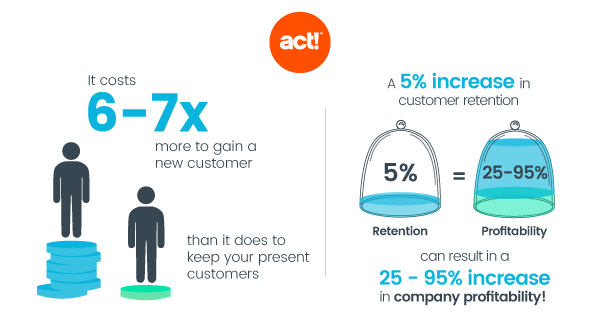
Image Source: Act
- Proactive Communication: Implement systems for proactive client communication, including regular check-ins, performance reviews, and strategic planning sessions.
- Value Demonstration: Develop sophisticated reporting and analysis tools that clearly demonstrate ROI and business impact. Clients who understand their return on investment are less likely to churn.
- Service Excellence: Maintain high service standards through quality assurance processes, regular training, and client feedback systems.
- Upselling Opportunities: Identify opportunities to expand services with existing clients. This might include additional service lines, increased service levels, or new business locations.
C. Financial Management and Profitability
- Revenue Optimization: Analyze client profitability and identify opportunities for pricing optimization or service efficiency improvements.
- Cost Management: Monitor and control costs associated with SEO partner services, team salaries, and technology tools. Look for economies of scale as you grow.
- Cash Flow Management: Implement robust invoicing and collection processes to maintain healthy cash flow. Consider offering annual payment discounts to improve cash flow predictability.
- Growth Investment: Allocate resources for continued growth, whether it's investing in new technology or expanding your team. Be strategic and prioritize investments that will have the greatest impact on your business.
- Client Retention: Don't neglect your current customers while focusing on acquiring new ones. Implement strategies to retain existing customers, such as offering loyalty programs or personalized communication.
- Partnerships and Collaborations: Consider forming partnerships or collaborations with other businesses in the industry to expand your reach and offer complementary services. This can help you tap into new markets and benefit from each other's expertise.
- Continuous Improvement: Always be on the lookout for ways to improve and optimize your processes, whether it's through adopting new technology, streamlining workflows, or implementing customer feedback. A continuous improvement mindset will help you stay competitive and provide the best possible products or services to your customers.
Enterprise-Level Systems and Processes
Scaling sustainably requires more than great talent—it needs robust systems that support growth without compromising efficiency or quality.
● Project Management at Scale: Scaling means juggling multiple projects, teams, and deadlines. Implement enterprise-level tools like DashClicks to streamline operations. Use customized workflows, agency automation processes, and cross-functional collaboration to ensure every task is on track and your entire team is aligned on priorities. These tools can also provide valuable insights into productivity and help identify bottlenecks early.
● Standard Operating Procedures (SOPs): Consistency is key to delivering high-quality work at scale. Every repeatable task, from onboarding new clients to campaign execution, should be documented and optimized. SOPs reduce the risk of human error, maintain brand consistency, and provide a clear framework for training new team members. This becomes especially crucial as your agency grows and your team expands.
● Client Lifecycle Automation: The client journey, from onboarding to offboarding, can be full of repetitive tasks that eat up time. Automating as much of this process as possible—without sacrificing personalization—frees up your team to focus on delivering value. Use tools like DashClicks to streamline communication, handle follow-ups, and ensure no step is missed, resulting in a seamless client experience.
Culture of Continuous Improvement
When your agency hits the milestone of 50 clients, it’s easy for complacency to sneak in. However, operational excellence isn’t a one-time achievement—it’s an ongoing commitment. The difference between surviving and thriving at this stage lies in fostering a culture of continuous improvement.
● Conduct Regular Performance Audits: Evaluate your team’s output, your reselling partner’s contributions, and client results on a regular basis. Identify gaps and areas for improvement, ensuring your agency delivers consistent results while staying ahead of industry trends.
● Review Churn Cases: Losing clients provides an opportunity to learn. Dive into churn cases to understand what went wrong, and use that feedback to fine-tune your processes and improve client satisfaction. Build systems to gather regular feedback from clients to prevent churn before it happens.
● Foster a Growth Culture: Encourage your team to embrace innovation, training, and process optimization as part of their daily routines. Create spaces for collaboration and reward employees who bring fresh ideas to the table or find ways to improve efficiency. A culture of learning and growth keeps your agency adaptive and competitive.
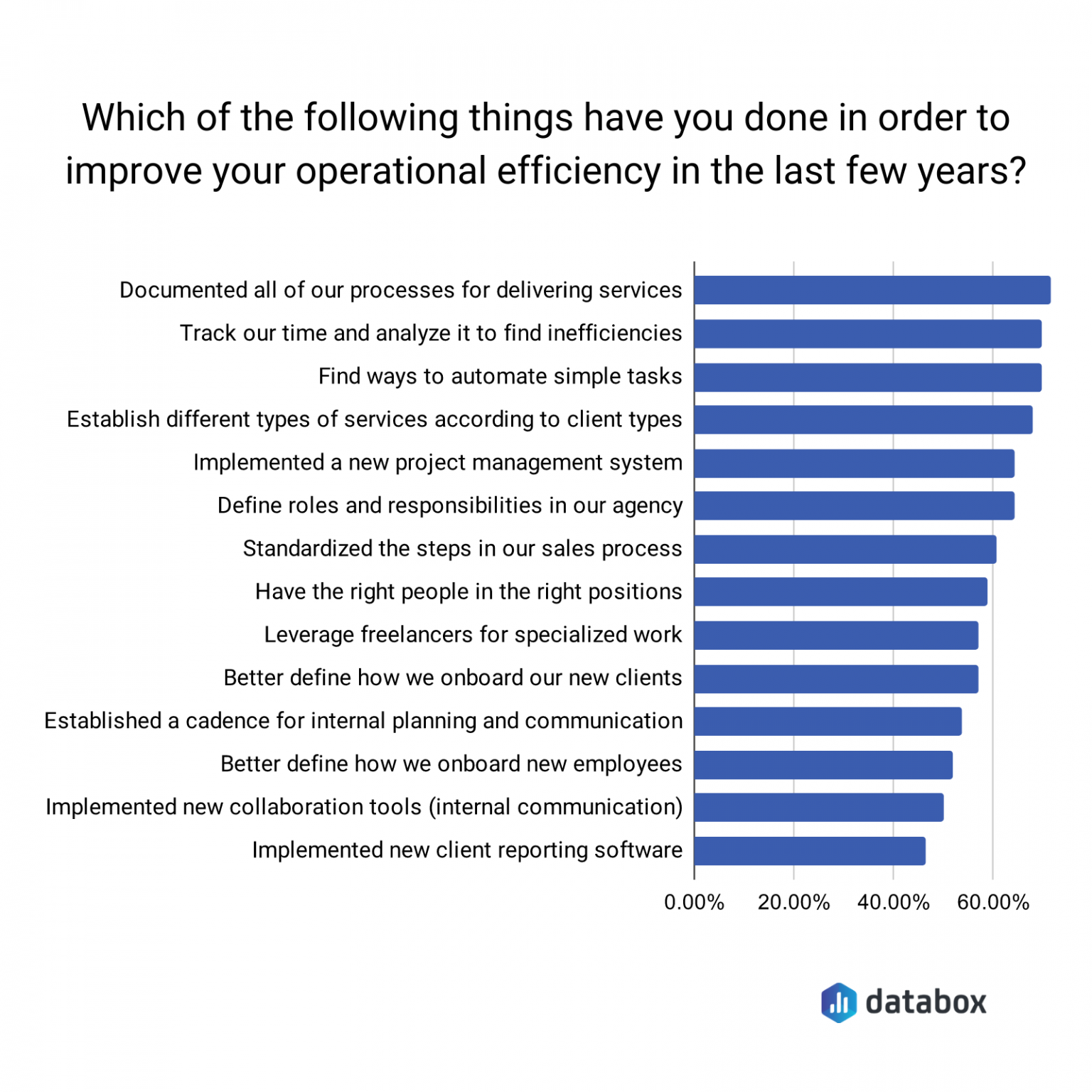
Image Source: Databox
What Comes After 50?
Reaching 50 clients isn’t the finish line—it’s the launchpad for new opportunities. At this stage, you’re in a position to expand in ways that can take your agency to the next level.
- Expand into New Verticals or Geographies: Leverage your expertise to tap into untapped markets or industries. With the right planning, new verticals or geographic expansions can open up significant revenue streams.
- Launch Franchise-Style Agency Branches: If your processes and systems are rock-solid, consider franchising your agency model. This allows you to scale your brand while maintaining consistency in service delivery.
- Develop Proprietary Tech or Tools: Differentiate yourself from competitors by building proprietary technology or tools that add unique value to your service offering. This could include client dashboards, analytics platforms, or even AI-driven solutions.
- Build Thought Leadership: Establish yourself as a leader in your space through podcasts, webinars, workshops, and speaking engagements. Sharing your expertise not only strengthens your brand but also helps attract clients and top-tier talent.
To scale beyond this milestone, your backend systems must be airtight. This demands reliable tools, efficient processes, and a culture of continuous improvement. With the right infrastructure in place, there’s no limit to what your agency can achieve—and a partner like DashClicks can help you get there faster and more effectively.
Why DashClicks Is the Perfect SEO Reselling Partner?
At this point in your growth journey, success hinges on two things: consistency in delivery and scalability in operations. That’s where a partner like DashClicks becomes indispensable.
DashClicks offers a complete white-label ecosystem tailored for agencies aiming to grow fast without compromising quality. Their SEO reseller services are backed by industry-best practices, transparent reporting, and dedicated fulfillment teams that know what it takes to get real results.
Here’s what you can expect with DashClicks:
- Prebuilt, high-converting SEO packages that cover everything from local SEO to advanced national campaigns.
- A white-labeled dashboard that keeps your clients engaged and informed at all times.
- InstaSites and InstaReports tools to boost your agency’s outreach and lead nurturing.
- Fast, responsive support to back your client-facing team.
- A dedicated SEO fulfillment team so you can focus on sales and scaling—not operations.
Whether you’re just getting started or already managing dozens of SEO clients, the agency is built to grow with you. Their platform gives you the infrastructure of a full-scale agency, without the overhead.
Ready to Go from 5 to 50 Clients?
Scaling your SEO reselling business doesn’t have to be overwhelming. With the right strategies, systems, and support, you can build a thriving agency that runs like a machine and delivers real results for your clients.
If you're ready to stop doing everything yourself and start growing your client base the smart way, it's time to partner with a proven SEO fulfillment provider.

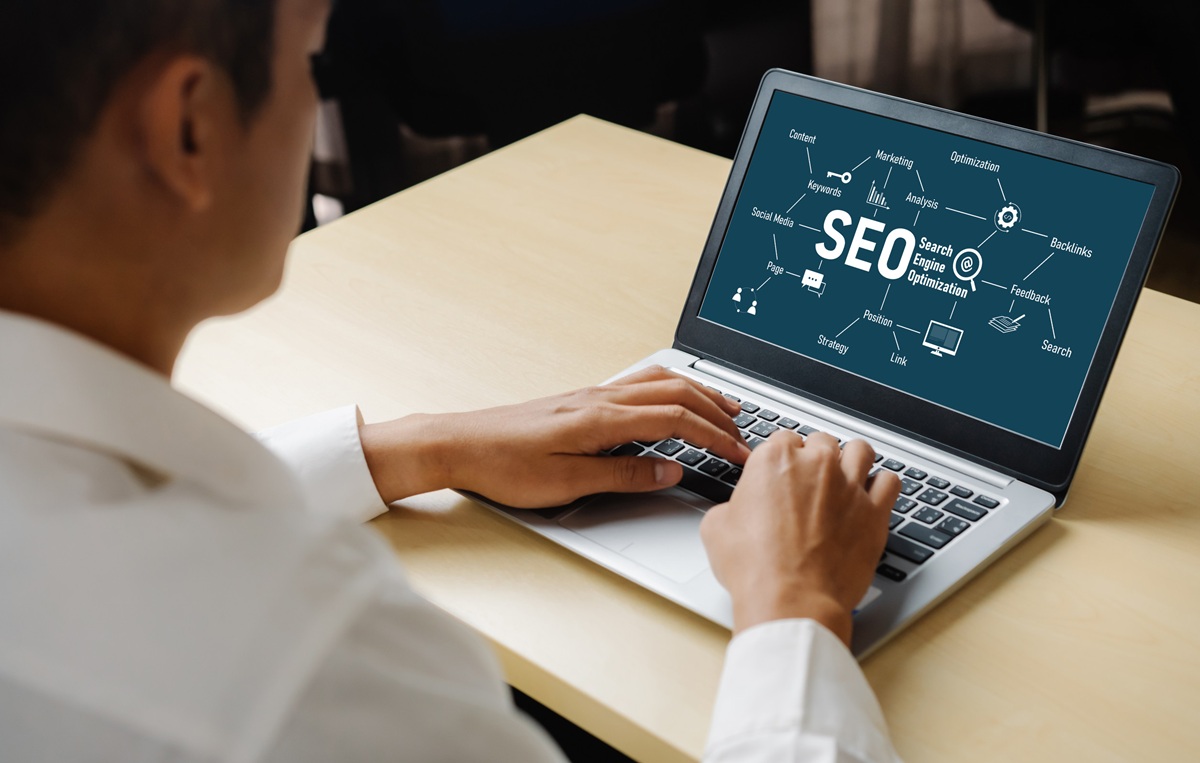
White Label SEO vs. In-House SEO: Which Path Leads to Success?
Agencies face a critical decision that can make or break their growth trajectory: should they build an in-house SEO team or partner with white label SEO services? This choice impacts everything from profit margins to client satisfaction rates.
The SEO industry generates over $80 billion annually, with agencies scrambling to capture their share. Yet many struggle with resource allocation, expertise gaps, and scaling challenges. Understanding the fundamental differences between white label and in-house SEO approaches will help you make the strategic decision that aligns with your agency's goals.
This comprehensive guide breaks down both models, examining costs, benefits, and real-world applications to help you choose the path that drives maximum results for your clients and your bottom line.
Understanding White Label SEO Services
White label SEO services allow agencies to outsource SEO work to specialized providers while maintaining their brand identity with clients. Think of it as having an invisible SEO department that works behind the scenes. In fact, according to HubSpot, 89% of marketers say SEO is a successful strategy for their business.
How White Label SEO Works?
A white label SEO company handles the technical execution while your agency manages client relationships. The process typically involves:
- Strategy Development: The white label provider creates customized SEO strategies based on your client's needs.
- Implementation: Technical SEO, content creation, and link building happen under your agency's brand.
- Reporting: Detailed reports arrive branded with your agency's logo and information.
- Communication: You remain the primary contact point for clients.
Key Benefits of White Label SEO Services
- Instant Expertise Access: White label providers employ specialists in technical SEO, content marketing, and link building. You gain access to expert-level knowledge without the hiring challenges.
- Scalability: Handle multiple clients simultaneously without expanding your team. White label partners can accommodate sudden growth spurts or seasonal demands.
- Cost Efficiency: Avoid salary expenses, benefits, training costs, and software subscriptions. Pay only for delivered services.
- Faster Market Entry: Launch SEO services immediately instead of spending months building internal capabilities.
- Risk Reduction: Established white label providers have proven processes and track records, reducing the risk of client dissatisfaction.

Image Source: White Label Agency
The In-House SEO Approach
In-house SEO involves building an internal team of SEO specialists who work exclusively for your agency. This approach offers direct control over every aspect of your SEO operations.
Building Your In-House SEO Team
Creating an effective in-house SEO team requires strategic planning and significant investment:
Essential Roles:
- SEO Manager or Director
- Technical SEO Specialist
- Content Marketing Specialist
- Link Building Specialist
- SEO Analyst
Infrastructure Requirements:
- Premium SEO tools
- Project management systems
- Reporting software
- Training and development programs
Advantages of In-House SEO
- Complete Control: Direct oversight of strategies, implementation, and quality standards. Make real-time adjustments without external coordination.
- Deep Client Understanding: In-house teams develop intimate knowledge of each client's business, industry, and unique challenges.
- Brand Alignment: Your team fully understands your agency's values, processes, and client service standards.
- Long-Term Investment: Building internal expertise creates lasting value for your agency.
- Profit Retention: Keep all revenue generated from SEO services instead of sharing with external providers.
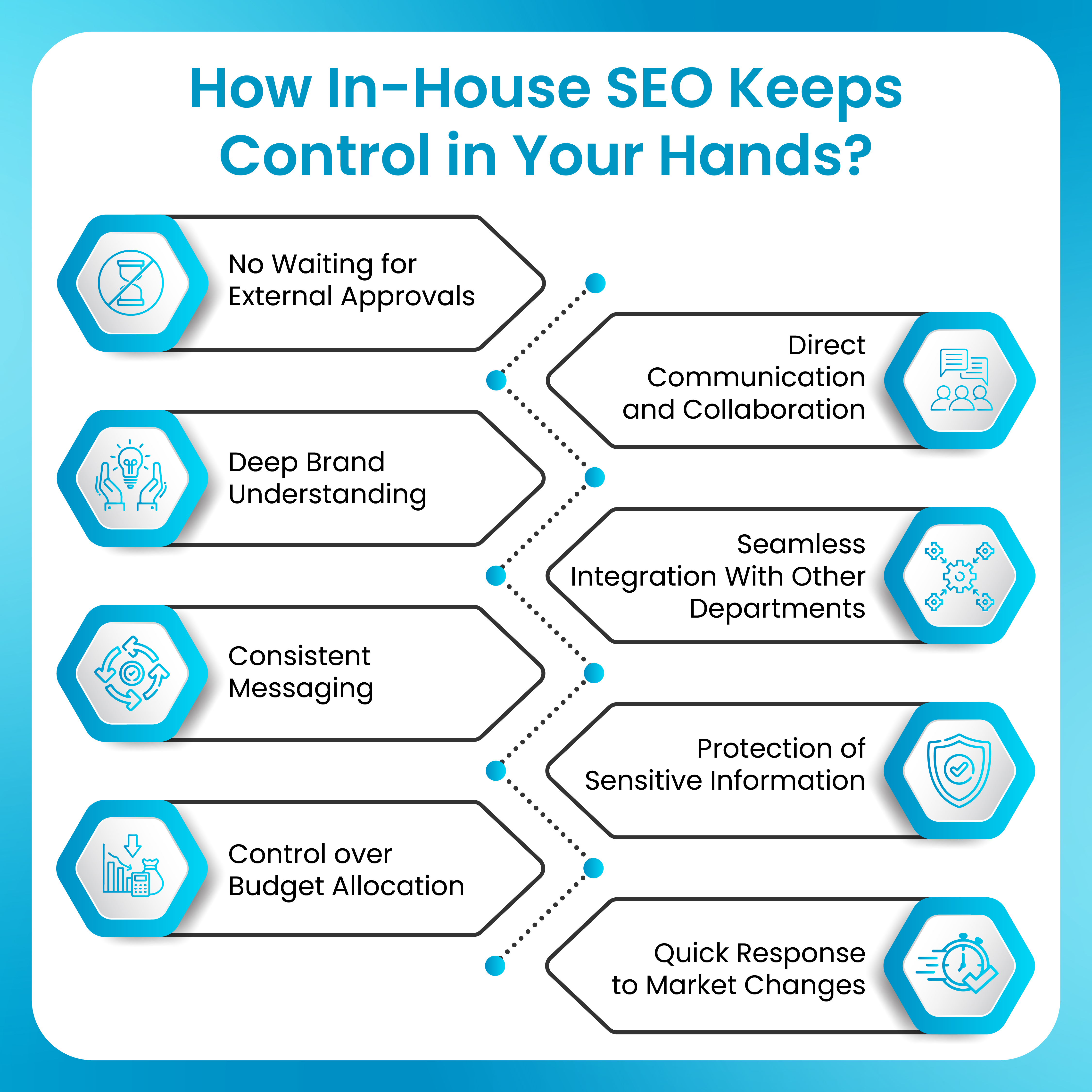
Cost Analysis: White Label vs. In-House
White Label SEO Costs
White label SEO services typically charge between $500-$2,000 per client monthly, depending on service scope and complexity. Additional considerations include:
- Setup Fees: $200-$500 per new client
- Custom Reporting: $50-$200 monthly
- Rush Projects: 20-50% premium rates
- Scaling Costs: Linear increase with client volume
In-House SEO Investment
Building an in-house SEO team requires substantial upfront and ongoing investment:
Annual Salary Costs:
- SEO Manager: $70,000-$120,000
- Technical SEO Specialist: $60,000-$100,000
- Content Specialist: $45,000-$75,000
- Link Building Specialist: $40,000-$70,000
Additional Expenses:
- Benefits (30% of salaries)
- SEO tools: $500-$2,000 monthly
- Training: $5,000-$15,000 annually
- Office space and equipment
Total First-Year Investment: $200,000-$400,000 for a basic team
Quality and Expertise Comparison
White Label SEO Quality Factors
- Specialization Advantage: White label companies focus exclusively on SEO, often developing superior expertise in specific areas.
- Industry Experience: Established providers have worked across multiple industries and verticals.
- Tool Access: Premium subscriptions to expensive SEO tools that might be cost-prohibitive for smaller agencies.
- Continuous Learning: Dedicated teams stay current with algorithm updates and industry changes.
In-House SEO Quality Considerations
- Learning Curve: New team members require time to reach peak performance levels.
- Knowledge Gaps: Difficult to hire specialists for every SEO discipline.
- Industry Updates: Requires ongoing training investment to maintain expertise.
- Resource Limitations: Smaller teams may struggle with complex technical challenges.

Image Source: Search Engine Journal
Scalability and Flexibility
White Label SEO Scalability
White label providers excel at handling rapid growth or seasonal fluctuations. They can:
- Onboard new clients within days.
- Adjust service levels based on demand.
- Handle multiple projects simultaneously.
- Provide backup coverage during peak periods.
In-House SEO Scaling Challenges
Internal teams face several scaling limitations:
- Hiring Delays: Finding qualified SEO professionals takes 3-6 months.
- Training Time: New hires need 6-12 months to reach full productivity.
- Fixed Costs: Salaries continue regardless of client volume.
- Capacity Constraints: Limited ability to handle sudden workload increases.
Client Satisfaction and Results
White Label SEO Performance
Success rates vary significantly among white label providers. Key performance indicators include:
- Average Ranking Improvements: 3-5 positions within 6 months.
- Organic Traffic Growth: 25-50% annually for established websites.
- Client Retention Rates: 80-90% for quality providers.
In-House SEO Outcomes
In-house teams often achieve strong results due to:
- Deep Client Relationships: Better understanding of business goals.
- Consistent Communication: Direct access to decision-makers.
- Customized Strategies: Tailored approaches for each client.
- Long-Term Focus: Ability to execute extended campaigns.
Making the Right Choice for Your Agency
When White Label SEO Services Work Best
1. Startup Agencies: For agencies just starting out, resources are often limited, and meeting immediate client demands can be challenging. White label SEO services allow startups to offer top-tier SEO without the need to hire in-house experts or invest heavily in tools and training. This enables them to focus on building their brand and acquiring clients.
2. Rapid Growth Phases: Agencies experiencing sudden expansion often struggle to keep up with the increased demand for services. White label providers can step in to handle the overflow, ensuring clients receive consistent, high-quality SEO services without the delays that come with hiring and training new staff.
3. Specialized Agencies: Agencies that focus on niche services like PPC, web design, or app development may not want to invest in building out a full SEO division. A white label SEO partner enables them to offer a broader range of services to their clients by leveraging the expertise of external providers without diverting resources from their core offerings.
4. Geographic Expansion: Agencies looking to enter new markets may find it challenging to build local expertise and expand their reach quickly. White label services can help them offer complete, localized SEO solutions without the need for significant upfront investment, making it easier to establish a presence in new regions.
When In-House SEO Makes Sense
1. Established Agencies: Agencies with stable revenue streams and a strong client base are often better positioned to build in-house SEO teams. This allows them to have more control over their strategies and align their services closely with their long-term growth goals. Investing in an internal team becomes a valuable asset as the agency scales.
2. Large Client Bases: Agencies managing more than 20 SEO clients monthly may find it cost-effective to build an internal team. At this scale, the high volume of work justifies the expense of hiring dedicated SEO professionals and purchasing the necessary tools, leading to better margins in the long run.
3. Premium Positioning: Agencies that target high-end clients and charge premium rates need to maintain direct control over the quality and delivery of their services. An in-house SEO team allows for greater oversight, customization, and the ability to build a reputation for excellence in the industry.
4. Strategic Focus: For companies that view SEO as a core competency rather than just an add-on service, building an in-house team makes sense. It enables them to develop unique strategies, innovate, and position themselves as leaders in the SEO space, setting them apart from competitors relying on outsourced solutions.
Hybrid Approach: Best of Both Worlds
Many successful agencies strategically combine in-house teams with white label support to maximize efficiency and flexibility:
1. Core Team + White Label Support: Keep in-house leadership and expertise to maintain control over strategy and client relationships while outsourcing specialized tasks like design, development, or paid media to trusted white label providers. This allows the agency to focus on its strengths while delivering a full-service experience.
2. Overflow Management: During peak periods, tight deadlines, or rapid growth phases, white label services can act as an extension of your team, ensuring no project is delayed and maintaining client satisfaction without the need to hire additional full-time staff.
3. Skill-Specific Partnerships: Some tasks, like technical SEO or website development, require niche expertise. By partnering with white label providers for these areas while managing content creation, strategy, and client communication internally, agencies can ensure high-quality execution without overextending their team’s capabilities.
4. Testing Ground: White label services are a great way to test new service offerings or gauge demand in specific areas before committing to hiring full-time staff or building internal teams. This approach allows agencies to scale thoughtfully and reduce risk.
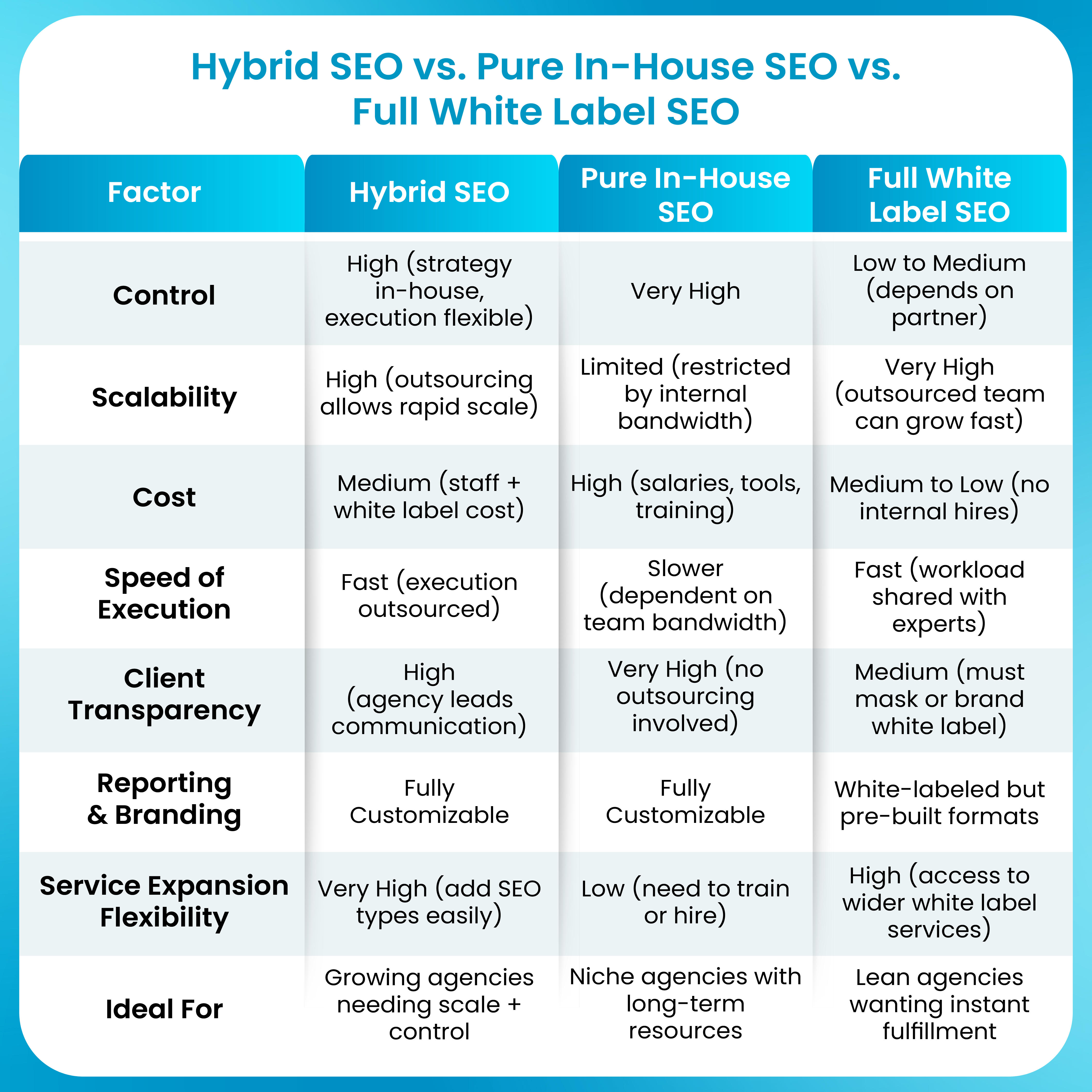
Future-Proofing Your SEO Strategy
The SEO landscape is constantly evolving, shaped by advancements like AI integration, voice search optimization, and mobile-first indexing. As these changes continue to redefine best practices, it’s crucial to consider key factors when choosing your approach to SEO strategy:
- Technology Adaptation: White label providers often invest in cutting-edge tools, software, and training at a faster pace than individual agencies. This means they can offer access to advanced analytics platforms, AI-driven keyword research, and automation tools that can enhance campaign effectiveness and save time.
- Algorithm Updates: Search engines frequently roll out algorithm changes, and staying on top of these updates is critical for maintaining rankings. Specialized white label providers typically have dedicated teams monitoring these updates, allowing them to quickly adapt strategies and minimize disruptions to your clients' SEO performance.
- Industry Trends: SEO trends are always shifting, from the rise of E-E-A-T (Expertise, Authority, Trustworthiness) to the growing importance of Core Web Vitals. Staying current with these trends requires focused effort and ongoing research, something white label companies are well-equipped to handle efficiently due to their scale and resources.
- Competitive Advantage: Choosing the right SEO approach should align with your agency's unique value proposition and market positioning. A strong partnership with a white label provider can help you offer a broader range of services or higher-quality results, giving you a competitive edge in a crowded market.
By considering these factors, you can make more informed decisions that not only enhance your agency’s services but also help your clients achieve long-term success in an ever-changing SEO landscape.
Scale Your Agency With DashClicks' White Label SEO Services
If your agency is looking to expand its SEO offerings without investing heavily in in-house resources, DashClicks is an excellent solution.
DashClicks provides comprehensive white label SEO services tailored to help agencies deliver outstanding results to their clients with ease. What sets them apart is its robust platform, which simplifies workflow management, acting as an all-in-one solution to save time and boost overall productivity.
With white label SEO services for agencies, gain access to an experienced team of SEO professionals who handle the heavy lifting, from keyword research and on-page optimization to backlink building and performance monitoring.
Their platform also offers detailed, white-labeled reporting tools, allowing you to present results directly to your clients under your own brand. Additionally, they offer customizable SEO packages, enabling agencies to cater to the unique needs of various clients, whether they’re startups or established businesses.
By leveraging DashClicks’ white label SEO services, your agency can focus on scaling, nurturing client relationships, and building long-term success—all while consistently delivering high-quality SEO outcomes for your clients. It’s a win-win solution for agencies aiming to grow efficiently and effectively in a competitive digital landscape.
Your Path to SEO Success
The decision between white label SEO services and in-house teams isn't about finding the "right" answer—it's about finding the right fit for your agency's current situation and future goals.
Start by honestly assessing your resources, client needs, and growth trajectory. Consider beginning with white label services to test market demand and client satisfaction before committing to internal team building. Remember that successful agencies often evolve their approach as they grow, starting with external support and gradually building internal capabilities.
The most important factor is taking action. Whether you choose white label SEO services, build an in-house team, or create a hybrid model, the key is providing consistent, high-quality SEO services that drive real results for your clients.
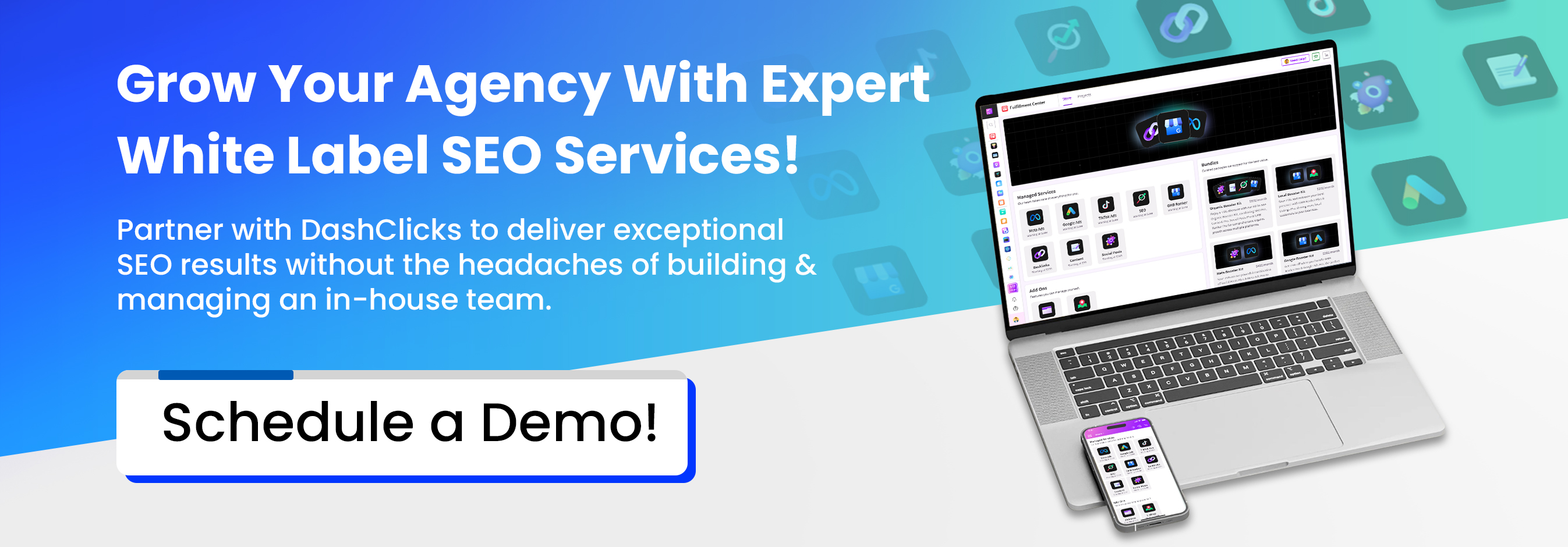
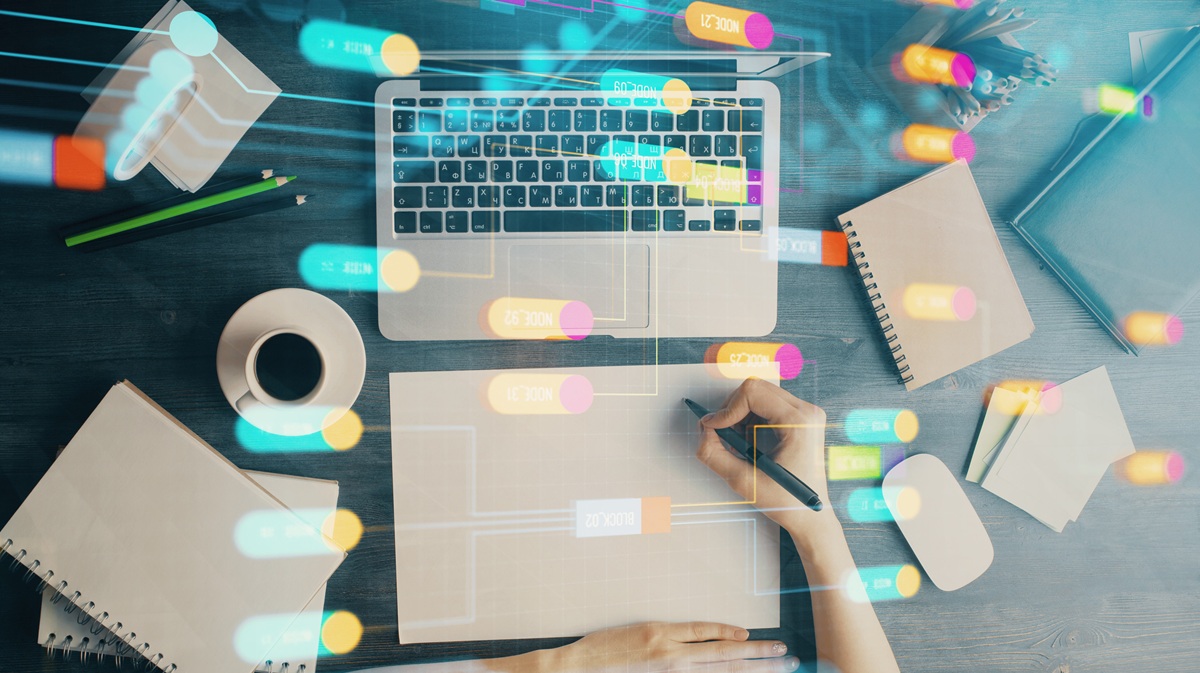
How to Position White Label SEO Services in Your Agency's Offering?
White label SEO services offer agencies a powerful way to expand their capabilities without building an in-house team. With nearly 93% of agencies already offering SEO services, positioning these solutions effectively can make the difference between thriving and merely surviving in today's competitive market.
The key to success lies in understanding how to present white label SEO as a strategic advantage rather than just another service add-on. This guide will show you exactly how to position these services to maximize client acquisition, retention, and profitability.
Why White Label SEO Is a Strategic Asset?
White label SEO services function as an invisible extension of your agency's capabilities. When you partner with a white label SEO agency, you gain access to specialized expertise while maintaining complete control over client relationships and brand presentation.
The arrangement works seamlessly: your white label provider handles the technical execution—keyword research, on-page optimization, link building, and performance tracking—while you focus on client management and business growth. All deliverables arrive branded with your agency's identity, ensuring clients see you as the SEO expert.
Core Components of White Label SEO Services
A comprehensive white label SEO program typically includes:
1. Technical SEO Foundation
- Website Audits and Optimization
- Site Speed Improvements
- Mobile Responsiveness Enhancements
- Schema Markup Implementation
2. Content Strategy and Creation
- Keyword Research and Mapping
- SEO-Optimized Content Development
- Blog Management and Optimization
- Local SEO Content for Location-Based Businesses
3. Authority Building
- Strategic Link-Building Campaigns
- Digital PR and Outreach
- Citation Building for Local Businesses
- Brand Mention Monitoring
4. Performance Tracking and Reporting
- Monthly Branded Reports
- Keyword Ranking Monitoring
- Traffic and Conversion Analysis
- Competitive Intelligence Updates
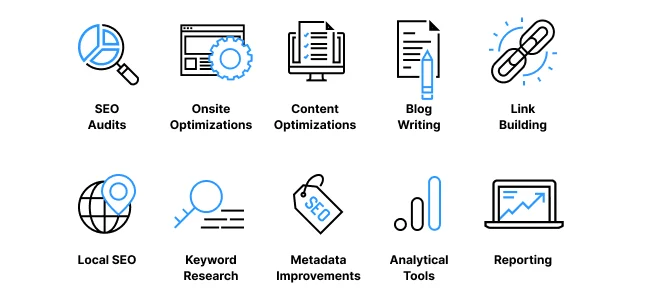
Image Source: Boostability
The Business Case for White Label SEO Services
1. Revenue Expansion Without Overhead
Traditional SEO team building requires a significant investment. Hiring experienced SEO professionals can cost $50,000-$80,000 annually per specialist, plus benefits, training, and ongoing education costs. White label SEO services eliminate these expenses while providing immediate access to expert-level capabilities.
Consider the math: A single SEO specialist earning $60,000 annually costs your agency approximately $78,000 when factoring in benefits and overhead. Meanwhile, white label SEO services for agencies typically cost 30-50% less while providing access to an entire team of specialists.
2. Speed to Market Advantage
Building internal SEO expertise takes months or years. White label partnerships allow you to launch professional SEO services within weeks. This speed advantage proves crucial when competing for clients who need immediate results.
Research shows that 49% of marketers consider SEO the highest ROI marketing channel. By quickly adding SEO to your service portfolio, you position your agency to capture this high-value demand.
3. Risk Mitigation
Google updates its search algorithm over 500 times annually. Keeping pace with these changes requires dedicated attention and expertise. White label SEO providers specialize in staying current with algorithm updates, ensuring your clients' campaigns remain compliant and effective.
Positioning Strategies for Maximum Impact
1. Position as Core Capability, Not Add-On
The most successful agencies position white label SEO as a fundamental part of their marketing service offerings rather than an optional extra. This approach requires confidence in your messaging and clear communication about SEO's importance.
Effective Positioning Language:
- "Our comprehensive digital marketing approach includes proven SEO strategies."
- "We deliver integrated marketing solutions that drive sustainable growth."
- "Our SEO expertise ensures your investment delivers long-term results."
Avoid Positioning Language:
- "We also offer SEO services."
- "SEO is available as an additional service."
- "We partner with others for SEO."
2. Leverage Industry Statistics
Data-driven positioning builds credibility and urgency. Use compelling statistics to demonstrate SEO's value:
- 75% of users never scroll past the first page of search results
- Organic search drives 53% of all website traffic
- SEO leads convert at 14.6% compared to 1.7% for outbound marketing
- Local searches result in purchases 28% of the time
3. Bundle for Maximum Value
Strategic bundling increases perceived value while simplifying client decision-making. Effective bundles combine complementary services that work synergistically.
High-Value Bundle Examples:
- Website Design + SEO Foundation Package
- PPC + SEO Integrated Growth Package
- Social Media + SEO Content Marketing Suite
- Local Marketing + SEO Visibility Package
Each bundle should clearly articulate how services work together to amplify results.
Client Acquisition Strategies
1. Consultative Selling Approach
Position yourself as a strategic advisor rather than a service provider. This approach builds trust and justifies premium pricing.
Discovery Questions to Ask:
- "How are potential customers currently finding your business?"
- "What percentage of your leads come from online searches?"
- "How do you measure against competitors in search results?"
- "What would a 30% increase in qualified leads mean for your business?"
These questions naturally lead to SEO discussions while demonstrating your strategic thinking.
2. Proof-Based Presentations
White label SEO services for agencies often include case studies and success stories you can rebrand. Use these strategically to build credibility.
Effective Proof Elements:
- Before/after ranking improvements
- Traffic growth metrics
- Lead generation increases
- Revenue impact data
- Client testimonials and quotes
Present proof in visual formats—charts, graphs, and screenshots—for maximum impact.
3. Competitive Positioning
Research prospects' competitors to identify SEO gaps and opportunities. This approach demonstrates expertise while creating urgency.
Competitive Analysis Points:
- Keyword gaps where competitors rank but prospects don't
- Content opportunities competitors are missing
- Technical SEO advantages that competitors have
- Local SEO weaknesses you can address

Image Source: Mailmodo
Pricing and Package Development
1. Value-Based Pricing Models
Move beyond hourly pricing to value-based models that reflect SEO's business impact. This approach increases profitability while aligning your success with client outcomes.
Pricing Model Options:
- Monthly retainer based on business size and complexity
- Performance-based fees tied to ranking improvements
- Project-based pricing for specific initiatives
- Hybrid models combining retainer and performance elements
2. Tiered Service Packages
Create clear service tiers that allow clients to choose appropriate investment levels while providing upgrade pathways. Example of tier structure:
A. Foundation Package ($1,500-$2,500/month)
- Technical SEO audit and fixes
- Basic keyword research and optimization
- Monthly reporting and recommendations
- Ideal for small businesses starting SEO
B. Growth Package ($2,500-$5,000/month)
- Comprehensive keyword strategy
- Content creation and optimization
- Link building campaigns
- Advanced reporting and analysis
- Perfect for established businesses scaling up
C. Enterprise Package ($5,000+/month)
- Full-service SEO management
- Integrated content marketing
- Advanced technical optimization
- Dedicated account management
- Custom reporting and strategy sessions
Implementation Best Practices
1. Partner Selection Criteria
Choose white label SEO services for agencies based on these critical factors:
A. Technical Expertise
- Proven track record with algorithm updates
- White-hat optimization practices
- Industry-specific experience
- Advanced tool access and utilization
B. Communication Standards
- Regular reporting schedules
- Transparent methodology explanations
- Responsive support availability
- Clear escalation procedures
C. Scalability Capabilities
- Ability to handle growth in client volume
- Consistent quality across projects
- Flexible service customization
- Reliable delivery timelines
2. Client Onboarding Process
Develop a systematic client onboarding process that sets clear expectations and demonstrates professionalism.
Onboarding Checklist:
- Initial SEO audit and opportunity assessment
- Goal setting and success metrics definition
- Competitive analysis and benchmarking
- Timeline and milestone establishment
- Communication protocol setup
- First-month strategy presentation

3. Performance Management
Establish clear metrics and reporting standards to ensure client satisfaction and identify improvement opportunities.
Key Performance Indicators:
- Keyword ranking improvements
- Organic traffic growth
- Lead generation increases
- Conversion rate improvements
- Client satisfaction scores
Common Positioning Mistakes to Avoid
1. Underpricing Services
Competing on price alone not only devalues your services but also attracts clients who may not fully appreciate the effort and expertise that goes into quality SEO work. SEO is a specialized skill that requires extensive knowledge, ongoing learning, and a strategic approach to deliver meaningful results.
When you underprice your services to win business, you risk undervaluing your time and effort, which can lead to quick burnout or resentment. Instead, focus on pricing your services to reflect the significant value you provide and the positive impact SEO can have on a client’s business.
2. Overpromising Results
SEO success is a long-term game, and it’s important to communicate this clearly to clients. Promising instant results might help secure a deal in the short term, but it sets unrealistic expectations and inevitably leads to disappointment when those promises aren’t met. SEO strategies typically take 4-6 months to deliver significant results, and that timeline can vary depending on the competitiveness of the industry.

Be upfront and transparent about the process, emphasizing the importance of patience and consistent effort in achieving sustainable growth. This honesty will build trust and strengthen client relationships over time.
Further Reading: Managing Client SEO Expectations: The Key to Success
3. Neglecting Client Education
Clients who understand the value of SEO are far more likely to be engaged, supportive, and satisfied with the work being done. Take the time to educate your clients about how SEO strategies are developed, the timelines involved, and the types of outcomes they can expect.
Share insights, reports, and case studies to help them see the bigger picture. When clients understand the nuances of SEO, they become collaborative partners rather than skeptics, which leads to smoother communication and better long-term outcomes for both parties.
4. Inadequate Provider Vetting
If you rely on white label providers to fulfill your SEO services, thorough vetting is essential. The quality of work delivered by white label partners can vary widely, and choosing the wrong one can harm your reputation and agency-client relationship. Before committing to a major partnership, take the time to research potential providers. Look into their track record, ask for references, and request samples of their work. Conduct small test projects to evaluate their capabilities before entrusting them with larger, high-stakes assignments. Proper vetting helps ensure you’re partnering with a reliable provider who aligns with your quality standards.
Measuring Success and ROI
1. Client Success Metrics
Track metrics that matter to clients' business objectives:
Traffic Metrics:
- Organic search traffic growth
- Keyword ranking improvements
- Search visibility increases
- Click-through rate improvements
Business Impact Metrics:
- Lead generation increases
- Conversion rate improvements
- Revenue attribution from organic search
- Cost per acquisition reductions
2. Agency Growth Metrics
Monitor your agency's growth and profitability:
Revenue Metrics
- Monthly recurring revenue from SEO services
- Average client lifetime value
- Upselling and cross-selling success rates
- Profit margins on SEO services
Operational Metrics
- Client retention rates
- Time to onboard new clients
- Service delivery efficiency
- Client satisfaction scores
Elevate Your Online Presence With DashClicks' Expert SEO Services
DashClicks provides a full range of professional SEO services tailored to businesses of all sizes, designed to deliver measurable and sustainable results. Our comprehensive approach ensures every aspect of your online visibility is optimized, helping you stay ahead of the competition and achieve long-term growth.
Here’s how DashClicks can transform your SEO strategy:
- Keyword Research: We identify the most relevant and high-performing keywords to ensure your site targets the right audience and drives quality traffic.
- On-Page Optimization: Our team optimizes your website content, metadata, and structure to improve its relevance and ranking potential for search engines.
- Technical SEO: We address critical technical aspects, such as site speed, mobile-friendliness, crawlability, and indexability, ensuring your site meets search engine requirements.
- Link Building: DashClicks builds high-quality backlinks that boost your domain authority and strengthen your online credibility.
Our strategies are powered by cutting-edge tools and a team of SEO experts who analyze performance data to continually adjust and improve campaigns. The result? Increased search engine rankings, enhanced organic traffic, and better ROI for your business.
When you partner with white label SEO agency, you’re not just investing in SEO services—you’re investing in the future growth of your business. Let us handle your SEO efforts efficiently while you focus on what you do best.
Transform Your Agency With Strategic SEO Positioning
White label SEO services represent more than just another revenue stream—they're a strategic advantage that can transform your agency's growth trajectory. By positioning these services as core capabilities rather than add-ons, you'll attract higher-quality clients, command premium pricing, and build lasting competitive advantages.
The key to success lies in thoughtful positioning, strategic partner selection, and consistent execution. Start by evaluating your current service portfolio, identifying SEO opportunities, and developing a positioning strategy that aligns with your agency's strengths and market position.
Ready to elevate your agency's SEO capabilities? Begin by researching white label SEO providers, developing your positioning strategy, and creating service packages that deliver exceptional value to your clients.
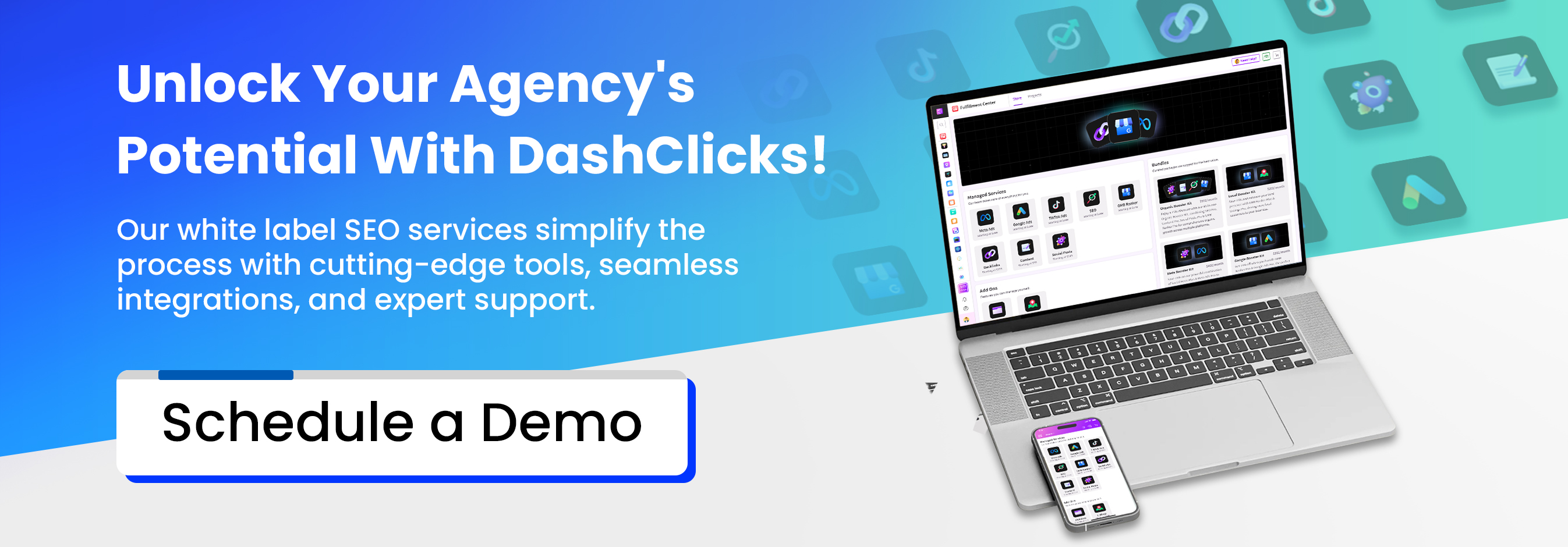

White Label SEO: Effective Outsourcing Strategies for SEO Services
Running a digital agency without SEO expertise? You're leaving money on the table. White label SEO services offer the perfect solution, letting you deliver premium SEO results under your brand without building an in-house team from scratch.
This comprehensive guide reveals how to outsource SEO services effectively, choose the right white label SEO partner, and scale your agency's revenue through strategic SEO outsourcing. Get ready to transform your service offerings and boost your bottom line.
How Does White Label SEO Outsourcing Work?
White label SEO outsourcing is a mutually beneficial arrangement where an agency partners with an external SEO provider to deliver high-quality SEO services under their own brand. Here's how it works step by step:
- Establish the Partnership – The first step involves selecting a reliable white label SEO partner. This provider should have proven expertise, transparency, and the ability to align with your agency's goals.
- Define Services and Goals – Once the partnership is established, you’ll outline the specific SEO services to be offered, such as keyword research, content creation, link building, and technical optimization, along with the desired outcomes for your clients.
- Client Onboarding – Your agency retains control of client relationships. You onboard your clients as usual, collecting all necessary information regarding their business, goals, and target audience.
- Delegate Work to the Provider – After gathering client data, the white label provider takes over the technical work, crafting tailored SEO strategies and executing them discreetly on your behalf.
- Deliver Results to Clients – The provider supplies detailed performance reports, branded with your agency’s logo. You then forward these results to your clients, maintaining the perception that your team carried out the work.
By outsourcing SEO to a white label partner, agencies can streamline operations, focus on their core strengths, and deliver exceptional results to clients without the need for extra staffing or expertise.
Why Outsource SEO Services?
The SEO landscape changes rapidly. Google releases thousands of algorithm updates annually, new tools emerge constantly, and best practices evolve at breakneck speed. Staying current requires dedicated resources that most agencies can't afford.

The Hidden Costs of In-House SEO
Building an internal SEO team might seem like a good idea, but the costs extend far beyond just salaries. Here’s what you need to consider:
- Recruitment Expenses: Hiring skilled SEO professionals is not only expensive but also time-consuming. It requires significant effort to find the right talent who can deliver measurable results.
- Training Investments: SEO is constantly evolving. To stay competitive, your team will need continuous training and education to keep up with algorithm updates, new strategies, and industry trends.
- Tool Subscriptions: Premium SEO tools are essential for success, but they come at a cost, often ranging from $500 to over $2,000 per month. These tools are non-negotiable for keyword research, analytics, and tracking.
- Opportunity Costs: Managing an in-house SEO team takes time and attention. This is time that could be better spent focusing on other growth opportunities, like acquiring new clients or refining your core services.
SEO Outsourcing Advantages
Savvy agencies understand that outsourcing SEO to a trusted partner offers both superior results and lower risk. Here’s why:
- Access to Premium Tools: White label SEO providers already have enterprise-grade software and tools at their disposal. You benefit from these resources without footing the high subscription costs yourself.
- Proven Processes: Established workflows and tested methodologies mean less trial and error. You gain access to processes that are already optimized to deliver results efficiently.
- Diverse Experience: Outsourced SEO teams have experience working with a variety of industries and challenges. This broad expertise allows them to approach your unique needs with innovative strategies.
- Consistent Results: With a dedicated team focused solely on SEO performance, you can expect consistent, measurable improvements in rankings, traffic, and overall digital presence.

By outsourcing SEO, you not only save money but also free up your time to focus on what you do best—growing your business. It’s a smart move for agencies that want to scale without the headaches of managing an in-house team.
How to Choose the Right White Label SEO Partner?
Not all white label SEO providers are created equal. Your choice directly impacts client satisfaction and your agency's reputation. Here are the essential evaluation criteria -
1. Track Record and Results
When choosing a white label SEO partner, their track record speaks volumes. Request case studies, client testimonials, and verifiable results to ensure they deliver what they promise. Look for:
- Evidence of consistent ranking improvements across multiple campaigns.
- Clear traffic growth metrics showing increased website visitors over time.
- Revenue impact data that highlights how SEO efforts have directly boosted client profitability.
- High client retention rates, demonstrating their ability to maintain long-term partnerships and deliver ongoing results.
2. Reporting and Communication
Transparent reporting and open communication are non-negotiable. Your chosen partner should provide:
- Branded reports customized with your agency's logo to maintain your brand identity.
- Detailed monthly performance summaries, breaking down metrics like rankings, traffic, and conversions.
- Regular strategy updates, giving you insights into what’s being done and what’s next.
- Direct communication channels, such as a dedicated account manager or team, to address questions or concerns promptly. Clear communication ensures seamless collaboration with your clients.
3. Service Offerings
A top-tier white label SEO provider should offer a wide range of services to meet diverse client needs. Their offerings should include:
- Comprehensive technical SEO audits to identify and resolve backend issues affecting site performance.
- In-depth keyword research and strategy development tailored to specific industries and client goals.
- Content optimization that aligns with SEO best practices, ensuring high-quality, search-friendly pages.
- Scalable link-building campaigns to improve domain authority and search rankings.
- Local SEO services (if applicable) to target region-specific audiences for businesses with a physical presence.
- Ongoing performance monitoring to adjust strategies and improve results continuously.
4. Scalability and Flexibility
Your ideal partner should be able to grow with your agency, offering scalability and adaptability. Look for a partner who can:
- Manage fluctuating workloads efficiently, ensuring deadlines are met even during peak demand.
- Tailor their approach to meet the unique needs of different clients across various industries.
- Scale their services as your agency expands, maintaining consistency in quality and delivery.
- Customize strategies to align with specific industries and target audiences, ensuring relevance and effectiveness.
By focusing on these essential criteria, you can find a white label SEO partner who not only delivers results but also enhances your agency’s reputation and client satisfaction.
Red Flags to Avoid
- Guaranteed Rankings: Be cautious of any SEO provider that promises specific rankings. Search engine algorithms are constantly changing, and no one can guarantee exact results. Legitimate providers focus on long-term strategies rather than quick, questionable fixes.
- Dirt-Cheap Pricing: While affordable options may seem tempting, quality SEO requires time, expertise, and resources. Unrealistically low prices often signal cut corners or ineffective techniques that can harm your website in the long run.
- Poor Communication: If an SEO provider is slow to respond or avoids answering your questions, it could be a red flag for poor client service. Open, responsive communication is key to a successful partnership.
- Lack of Transparency: Providers who refuse to share their methods or strategies may be using black-hat techniques that can lead to penalties from search engines. Look for SEO teams that are open about their processes and adhere to ethical practices.

Image Source: White Label Agency
Effective SEO Outsourcing Strategies
Scaling your agency through white label SEO services requires more than simply outsourcing tasks—it calls for structured planning, seamless execution, and strategic alignment with your brand and client goals. Here are four key pillars of a successful SEO outsourcing strategy:
1. Develop a Purpose-Driven White Label SEO Strategy
Before you outsource, define your SEO service offering. Keep core competencies like content creation in-house to maintain your agency’s voice, while outsourcing time-intensive or technical areas like link-building, technical audits, and local SEO to expert partners.
Set clear goals and KPIs for every campaign, ensuring expectations are measurable and aligned. Your clients should see seamless delivery—every report, dashboard, and deliverable should reflect your agency’s branding. According to a HubSpot report, 71% of marketers say branding consistency directly contributes to customer trust and loyalty, making white-labeled deliverables a must.
Also, define the client experience. Decide who handles strategy calls, updates, and onboarding. Most agencies retain communication while allowing white-label partners to execute behind the scenes.
2. Break Down Fulfillment With Task Segmentation
White label SEO works best when campaigns are broken into well-defined tasks—think keyword research, content writing, on-page optimization, link-building, and local citations. Assign each task to the most qualified internal team member or outsourcing partner.
Utilize tools like DashClicks’ project management software, a dedicated white-label platform, to track workflows in real-time. This avoids bottlenecks and ensures consistent delivery.
Remain Flexible: outsource advanced technical work (like schema markup or site speed optimization) to reduce initial costs, and scale in-house resources only when your client base demands it.
3. Integrate White Label SEO into Agency Operations
To build trust with clients, your operations must run like a well-oiled machine. Create internal systems for regular check-ins, reporting timelines, and data-sharing protocols with your white-label team.
Invest in branded dashboard software - like the ones offered by DashClicks - that showcase keyword rankings, traffic growth, and campaign insights under your agency’s logo. This gives your clients a professional and consistent brand experience without exposing your outsourcing partner.
Make sure your internal team is well-trained on outsourced services. Your sales and account managers should be able to clearly explain deliverables, set accurate expectations, and answer client questions confidently.

4. Scale Strategically With the Right Partnerships
The real advantage of white label SEO is scalability. Partnering with the right provider allows you to onboard multiple new clients quickly, often growing 3–4× faster without increasing headcount.
Outsourcing also reduces overhead. For example, replacing one full-time SEO specialist (approx. $60,000/year) with a flexible partner can cut costs by 30–50%, according to Stan Ventures. These savings boost your profit margins while keeping pricing competitive.
White label SEO also enables diversification. Want to offer international SEO or dive into technical SEO overnight? The right partner gives you that flexibility without training a new hire. Plus, top-tier partners stay current on algorithm updates and industry-specific best practices, delivering better long-term ROI than most small internal teams can manage.
Maximizing ROI from White Label SEO Services
White label SEO lets you scale your agency quickly and efficiently by outsourcing tasks to experts. To maximize your return on investment, implement these proven strategies:
1. Pricing Strategies That Win
- Value-Based Pricing: Focus on charging for the results you deliver, rather than hourly rates, highlighting the ROI of your services.
- Tiered Service Packages: Offer basic, standard, and premium options to cater to different client needs and budgets.
- Performance Bonuses: Include incentive-based pricing tied to specific achievements, like ranking improvements or traffic growth.
- Annual Contracts: Encourage long-term commitments with discounted rates for clients who sign up for 12-month agreements, ensuring steady income.
Strategic pricing not only appeals to a wide range of clients but also emphasizes the value of your services.
2. Client Communication Best Practices
Effective communication is crucial for maintaining strong client relationships and ensuring satisfaction. Best practices include:
- Set Clear Expectations: Help clients understand the timelines and realistic outcomes of an SEO campaign to manage their expectations.
- Regular Updates: Provide monthly reports and strategy calls to keep clients informed about progress and results.
- Educational Content: Share insights about SEO trends and best practices to position yourself as an expert and build trust.
- Proactive Recommendations: Identify potential improvements or challenges before they arise, showcasing your dedication to their success.
Transparent and proactive communication ensures clients feel valued and confident in your services.
3. Building Long-Term Client Relationships
Sustainable growth relies on nurturing strong client relationships over time. To foster loyalty and trust:
- Consistent Results: Deliver measurable improvements in rankings, traffic, and conversions month after month.
- Transparent Reporting: Be open about both successes and challenges, showing that you’re committed to solving problems.
- Strategic Guidance: Offer insights that go beyond SEO, helping clients with broader business goals like audience targeting or branding.
- Responsive Support: Address client questions and concerns quickly, demonstrating reliability and professionalism.
Building long-term relationships not only secures recurring revenue but also increases the likelihood of referrals and positive testimonials.
By implementing these strategies, your agency can thrive in the competitive SEO industry while delivering exceptional value to clients.
Common SEO Outsourcing Mistakes to Avoid
Learn from these critical errors that can derail your white label SEO outsourcing success.
Mistake 1: Choosing Based on Price Alone
The cheapest option rarely delivers the best results. Low-cost providers often:
- Use outdated techniques
- Provide minimal reporting
- Offer poor communication
- Deliver inconsistent results
Mistake 2: Insufficient Client Education
Clients who don't understand SEO become frustrated with timelines and results. Always:
- Explain the SEO process clearly
- Set realistic expectations
- Provide regular education
- Celebrate small wins
Mistake 3: Neglecting Quality Control
Review your white label partner's work regularly:
- Audit monthly reports
- Check client website improvements
- Monitor ranking progress
- Verify link quality
Mistake 4: Poor Internal Processes
Establish clear workflows for:
- Client onboarding
- Communication protocols
- Reporting schedules
- Problem resolution
Scaling Your Agency With SEO Outsourcing
White label SEO services provide the foundation for sustainable agency growth.
1. Revenue Growth Opportunities
- Expand Client Base: Attract businesses needing SEO expertise.
- Increase Client Value: Add SEO to existing accounts.
- Develop Specializations: Focus on high-value industry niches.
- Create Partnerships: Collaborate with complementary service providers.
2. Operational Efficiency Gains
- Streamlined Processes: Established workflows reduce management time.
- Predictable Costs: Fixed pricing simplifies budgeting.
- Reduced Overhead: Eliminate in-house SEO department costs.
- Better Resource Allocation: Focus team on core competencies.
3. Competitive Advantages
- Full-Service Capability: Offer comprehensive digital marketing solutions.
- Faster Implementation: Launch SEO campaigns immediately.
- Expert Credibility: Leverage partner expertise for client confidence.
- Scalable Solutions: Handle growth without hiring constraints.

Image Source: Pearl Talent
What Makes DashClicks a Great SEO Outsourcing Agency?
DashClicks stands out as a top-tier SEO outsourcing agency due to its robust platform, exceptional services, and commitment to client success. Their white label dashboard is designed to streamline workflows, providing agencies with a seamless experience for managing campaigns, tracking performance, and delivering results. They offer a wide range of SEO services, including keyword research, on-page and off-page optimization, and comprehensive reporting, all tailored to meet the needs of your clients.
Additionally, their white label SEO services includes fully branded reporting, enabling agencies to present professional deliverables under their own brand. The company's focus on transparency, dedicated customer support, and consistent results builds trust and fosters long-term partnerships. Whether you're looking to scale your agency or expand service offerings, DashClicks' comprehensive tools and expert team make them an ideal choice for SEO outsourcing.
Taking Action: Your Next Steps
Ready to transform your agency with white label SEO services? Here's your roadmap to success:
Immediate Actions:
- Research and contact 3-5 white label SEO providers
- Request case studies and client references
- Evaluate pricing and service offerings
- Schedule discovery calls with top candidates
Within 30 Days:
- Select your white label SEO partner
- Develop branded reporting templates
- Create SEO service packages
- Identify target clients for outreach
Within 60 Days:
- Launch your first SEO campaigns
- Establish regular reporting schedules
- Begin prospecting for new SEO clients
- Refine your sales process
White label SEO services offer unlimited potential for agency growth. The question isn't whether you should outsource SEO services - it's how quickly you can get started. Your competitors are already leveraging these partnerships to steal market share. Don't let them leave you behind.
Take the first step today. Research white label SEO providers, evaluate their capabilities, and choose the partner who can accelerate your agency's success. Your future self will thank you for this decisive action.


Benefits of Offering White Label SEO to Your Clients
Running a digital marketing agency means juggling countless responsibilities while trying to deliver exceptional results for every client. What if there was a way to expand your service offerings, boost revenue, and enhance client satisfaction without stretching your team thin? Enter white label SEO—a game-changing solution that's transforming how agencies operate and grow.
White label SEO allows you to offer comprehensive search engine optimization services under your brand name while partnering with specialized providers who handle the technical execution. This strategic approach enables agencies to deliver professional SEO results without building an in-house team from scratch.
This comprehensive guide explores the compelling benefits of incorporating white label SEO into your agency's service portfolio, from cost savings and scalability to improved client retention and market expansion opportunities.
Who Can Benefit from White Label SEO?
White label SEO services provided by specialized SEO companies allow digital agencies, marketing firms, or other businesses to offer SEO services under their own brand name.
Essentially, it's a "ready-to-go" solution where the technical work—like keyword research, on-page optimization, content creation, link building, and performance tracking—is handled behind the scenes by experts. The agency or business presenting the service takes credit for delivering high-quality SEO results, maintaining their branding throughout the process. This seamless collaboration ensures that the end client experiences excellent results without knowing a third-party provider is involved.
A white label SEO is ideal for agencies and businesses that want to include SEO services in their offerings but lack the resources, time, or expertise to build an in-house SEO team. It's especially valuable for web design firms, advertising agencies, and digital marketers focused on scaling their operations without overwhelming their existing staff or infrastructure.
White label SEO company can provide immense benefits across a variety of niches. These include:
- SaaS Companies: White label SEO company help SaaS companies focus on developing their software while outsourcing search engine optimization to experts. This allows them to improve their online visibility, attract more qualified leads, and remain competitive in a crowded market.
- Local Service Businesses: For local service providers like plumbers, cleaners, or electricians, white label SEO ensures better local search rankings. By leveraging specialized SEO services, these businesses can attract more nearby customers and grow their client base.
- E-commerce Stores: E-commerce businesses benefit from white label SEO by driving more organic traffic to their product pages. With optimized product descriptions, better search rankings, and targeted keywords, they can see increased sales and higher conversions.
- B2B Tech Firms: B2B tech companies often require niche-specific targeting. White label SEO partnerships help them focus on building relationships with their clients, while an SEO partner ensures that their content reaches the right business audience.
- Digital Agencies: Digital agencies can expand their service offerings by partnering with white label SEO providers. This allows them to offer SEO services to their clients without hiring in-house experts, saving time and resources while scaling their business.
Even startups and smaller agencies can benefit from white label SEO, as it provides a cost-effective way to compete with larger players in the industry while maintaining a high standard of service. Whether you're aiming to expand service offerings, streamline operations, or build better client relationships, white label SEO is a smart, scalable solution for agencies of all sizes!
Further Reading: White Label SEO: The Complete Agency Growth Guide
Why You Should Consider It: 10 Compelling Reasons
Making a big decision can feel overwhelming, but breaking it down into clear reasons can help. Here are 10 compelling points to consider that might just make your choice a little easier!
1. Focus on Your Core Strengths
Your agency excels at specific services—whether that's paid advertising, social media management, or web design. White label SEO partnerships allow you to concentrate on these core competencies while still offering comprehensive digital marketing solutions.
According to the Promethean Research, Digital Agency Industry Report, 83% of agencies specialize - either by service or niche - and those agencies tend to grow faster. When you're not splitting attention between multiple specializations, you can deliver superior results in your primary areas of expertise.
This focused approach also improves team morale and productivity. Your staff can dedicate their energy to mastering skills they're passionate about rather than struggling with unfamiliar SEO technicalities like keyword research, link building, or technical audits.
Streamlined Operations: White label SEO eliminates the complexity of managing multiple service lines internally. Your team maintains a clear workflow while your white label partner handles all SEO-related tasks, from strategy development to implementation and reporting.

This streamlined approach increases marketing agency operational efficiency, reduces internal confusion, and ensures consistent service delivery across all client accounts.
2. Leverage Specialized Expertise
SEO requires deep technical knowledge, constant algorithm updates awareness, and sophisticated tools proficiency. White label providers employ specialists who live and breathe search engine optimization daily.
These experts understand intricate ranking factors, penalty recovery strategies, and advanced optimization techniques that would take your team months or years to master. A 2023 survey revealed that 73% of businesses working with SEO specialists see improved rankings within six months compared to 41% handling SEO internally.
Staying Current With Algorithm Changes: Google updates its algorithm over 600 times annually, with major updates significantly impacting search rankings. White label SEO providers monitor these changes continuously and adjust strategies accordingly, ensuring your clients' websites remain competitive.
Your agency benefits from this expertise without investing time in constant industry education or algorithm analysis.
3. Comprehensive Service Solutions
White label SEO programs typically offer complete service packages including keyword research, content optimization, technical SEO audits, link building, and performance reporting. This one-stop approach simplifies vendor management and ensures consistent service quality.
AgencyAnalytics’ 2023 survey of over 1,000 agencies found that 70% of agencies—many of which offer a diverse service mix—retain clients for more than 2 years. Clients prefer working with single providers who can handle multiple aspects of their digital presence.
Integrated Marketing Strategies: White label partnerships enable seamless integration between SEO and your existing services. Social media efforts can support SEO goals, while paid advertising campaigns can complement organic search strategies, creating powerful synergies that drive better results.
4. Flexible Partnership Terms
Many white label SEO providers offer flexible arrangements without long-term contracts, allowing agencies to scale services based on client demand. This flexibility eliminates the financial risk associated with hiring full-time SEO specialists.
You can start with one or two client projects to test the partnership quality before expanding your SEO service offerings across your entire client base.
On-Demand Scalability: As your agency grows, white label partnerships can instantly accommodate increased demand. Whether you need SEO services for five clients or fifty, your provider can scale resources accordingly without requiring additional infrastructure investments from your agency.

Image Source: Gainapp
5. Significant Cost Savings
Building an in-house SEO team requires substantial investments in salaries, benefits, training, and premium tools. SEO software subscriptions alone can cost $500-$2,000 monthly per user for comprehensive platforms.
White label SEO eliminates these overhead costs while providing access to enterprise-level tools and expertise. Agencies typically save 40-60% compared to hiring equivalent in-house capabilities.
Tool Access Benefits: Professional SEO requires expensive tools like SEMrush, Ahrefs, Screaming Frog, and others. White label providers already maintain these subscriptions, giving your agency access to premium tools without direct costs.
This tool access alone can justify white label partnerships, as individual subscriptions would cost thousands monthly.
6. Enhanced Revenue Opportunities
Existing clients represent your most valuable revenue source, with acquisition costs significantly lower than finding new customers. White label SEO allows you to expand services for current clients, increasing account values and lifetime revenue.
Studies indicate that agencies that successfully upsell to existing clients see average account values increase by 45-70%. This revenue boost comes with minimal additional sales effort since trust relationships already exist.
Recurring Revenue Streams: SEO services generate predictable monthly recurring revenue, providing financial stability for your agency. Unlike project-based work, SEO requires ongoing optimization and monitoring, creating long-term client relationships. This recurring revenue model improves cash flow predictability and supports sustainable business growth.

Image Source: Agency Analytics
7. Minimized Market Entry Risks
Entering new service markets typically involves significant risks, including staff hiring, training investments, and potential client disappointment during learning curves. A white label SEO agency eliminates these risks by providing proven expertise from day one.
Your agency can test market demand for SEO services without upfront investments or long-term commitments. If demand proves strong, you can expand the partnership. If not, you can discontinue services without financial losses.
Competitive Advantage: Offering comprehensive digital marketing services, including SEO, positions your agency competitively against larger firms. Clients increasingly prefer working with agencies that can handle multiple marketing channels rather than managing separate vendors.
8. Accelerated Growth Potential
White label SEO partnerships enable rapid service expansion without the typical challenges of hiring, training, and scaling internal teams. Your agency can immediately offer professional SEO services to new and existing clients.
This acceleration is particularly valuable during growth periods when hiring qualified SEO specialists becomes challenging due to market competition and lengthy onboarding processes.
Market Expansion Opportunities: SEO services are in high demand across industries, creating opportunities to expand into new market segments. Your agency can leverage white label partnerships to serve clients in industries where you previously lacked SEO expertise.
9. Advanced Strategy Implementation
White label SEO providers utilize sophisticated strategies, including technical SEO audits, advanced schema markup, international SEO optimization, and enterprise-level link building campaigns. These strategies require specialized knowledge and tools that individual agencies rarely possess.
Access to advanced strategies enables your agency to compete for larger clients and more complex projects, expanding your total addressable market.
Cutting-Edge Techniques: SEO constantly evolves with new optimization techniques, algorithm updates, and ranking factors. White label providers invest heavily in staying current with industry developments, ensuring your clients benefit from the latest optimization strategies.
10. Improved Client Satisfaction and Retention
Professional SEO services delivered through white label partnerships typically achieve better results than inexperienced internal efforts. Better results lead to higher client satisfaction, stronger relationships, and improved client retention rates.
Data shows that agencies offering comprehensive SEO services maintain client relationships longer than those providing limited services. Satisfied clients also generate more referrals, supporting organic agency growth.

Transparent Reporting: Quality white label SEO providers deliver detailed reporting that you can brand and present to clients. These reports demonstrate clear ROI and progress, supporting client confidence in your agency's capabilities.
How Leveraging DashClicks' SEO Services Can Make a Difference?
DashClicks offers a unique approach to SEO services that empowers agencies to outperform the competition. Our white label SEO services are designed to maximize your clients' online success while seamlessly integrating under your brand. Here's what sets us apart:
- Comprehensive and Customizable SEO Solutions: With DashClicks, you gain access to a full suite of SEO services, including keyword research, on-page optimization, technical SEO audits, high-quality backlink building, and local SEO strategies. Our services are built to cater to diverse industries and client needs, offering a level of customization that ensures each campaign drives maximum results.
- Experienced & Dedicated SEO Teams: Unlike many generic providers, DashClicks assigns a dedicated team of in-house SEO experts to every project. Our specialists analyze your clients' goals, industry trends, and competition to craft tailored strategies that deliver measurable success. Every aspect of the campaign is managed with precision and care, saving you time while delivering excellence to your clients.
- Scalable Solutions Built for Growth: Whether you’re managing one campaign or handling dozens, DashClicks makes scaling effortless. Our processes are streamlined to balance high-quality execution with efficiency, allowing you to manage multiple clients effortlessly. You can focus on growing your agency while we handle the heavy lifting behind the scenes.
- Real-Time White-Label Reporting: Transparency is at the core of our service. With DashClicks, you’ll receive real-time reports through our user-friendly dashboard, branded with your agency’s logo. These detailed reports showcase campaign performance, keyword rankings, and ROI metrics, enabling you to confidently present results to your clients and boost their trust in your expertise.
- Affordable, Agency-Friendly Pricing: We truly understand agency challenges, so our pricing model is designed to fit your budget while offering impactful results. This allows you to maintain competitive pricing for your clients while optimizing profit margins for your business.
By partnering with DashClicks for SEO, agencies can deliver superior service, retain clients longer, and scale faster—all while maintaining complete control over their brand identity. Step up your game and see how DashClicks can transform your agency’s potential today!
Transform Your Agency With White Label SEO
White label SEO partnerships offer agencies a powerful path to growth, profitability, and market expansion. By leveraging specialized expertise, reducing operational complexity, and providing comprehensive services, agencies can focus on their core strengths while delivering exceptional results across all service lines.
The benefits extend beyond simple cost savings to include enhanced client satisfaction, recurring revenue opportunities, and competitive advantages that position your agency for long-term success.
Ready to explore white label SEO opportunities? Research potential partners, evaluate service offerings, and consider starting with a small pilot program to experience the benefits firsthand. Your agency's growth potential—and your clients' success—depends on making strategic decisions that enhance capabilities while maintaining operational efficiency.


No results found.
Please try different keywords.
Get Started with
DashClicks Today
Get found online, convert leads faster, generate more revenue, and improve your reputation with our all-in-one platform.
.svg)
Unlimited Sub-Accounts
.svg)
Unlimited Users
.svg)
All Apps
.svg)
All Features
.svg)
White-Labeled
.svg)
Active Community
.svg)
Mobile App
.svg)
Live Support
.svg)
100+ Tutorials
.svg)
Unlimited Sub-Accounts
.svg)
Unlimited Users
.svg)
All Apps
.svg)
All Features
.svg)
White-Labeled
.svg)
Active Community
.svg)
Mobile App
.svg)
Live Support
.svg)
100+ Tutorials
.svg)
Unlimited Sub-Accounts
.svg)
Unlimited Users
.svg)
All Apps
.svg)
All Features
.svg)
White-Labeled
.svg)
Active Community
.svg)
Mobile App
.svg)
Live Support
.svg)
100+ Tutorials



.svg)
.svg)
.svg)
.svg)
.svg)


